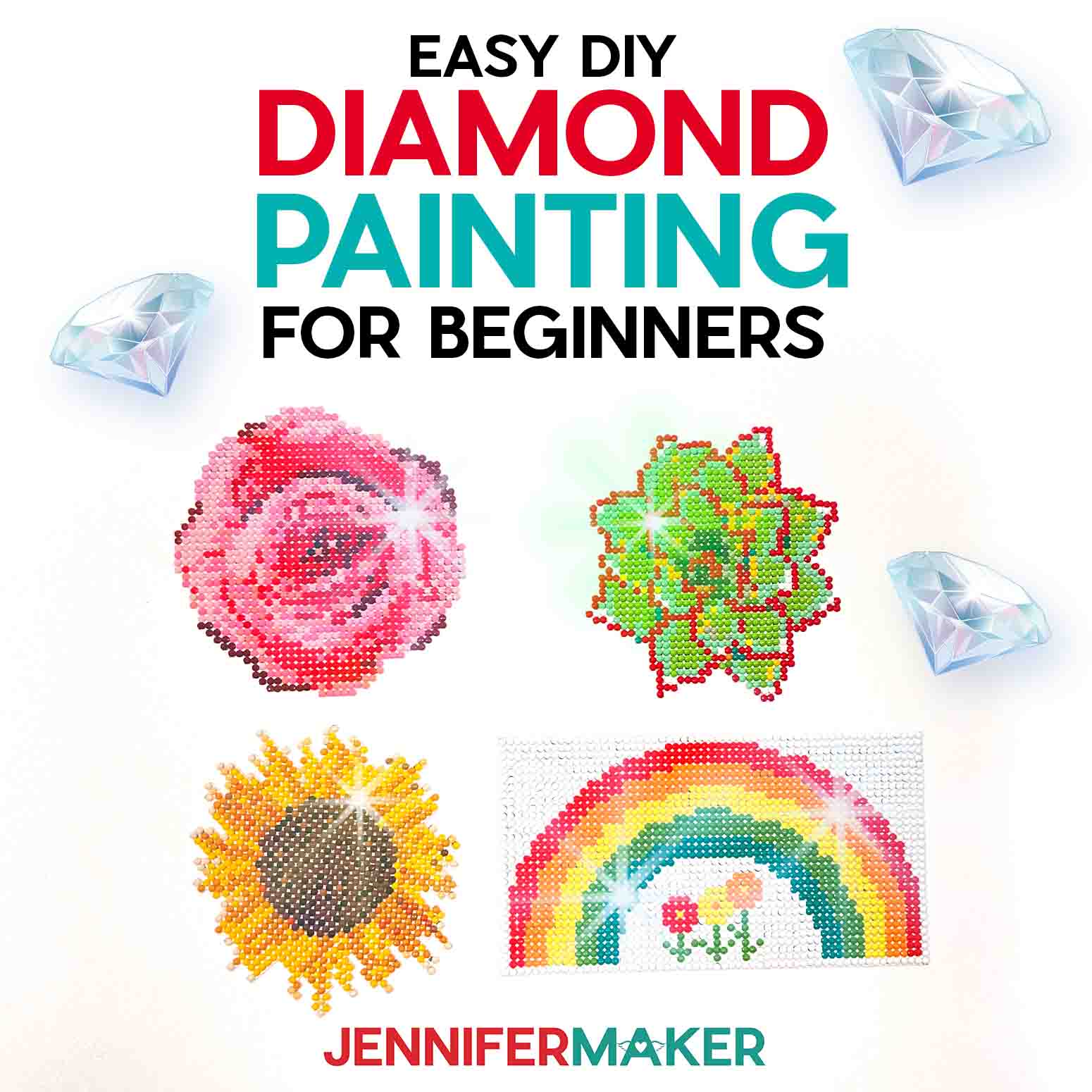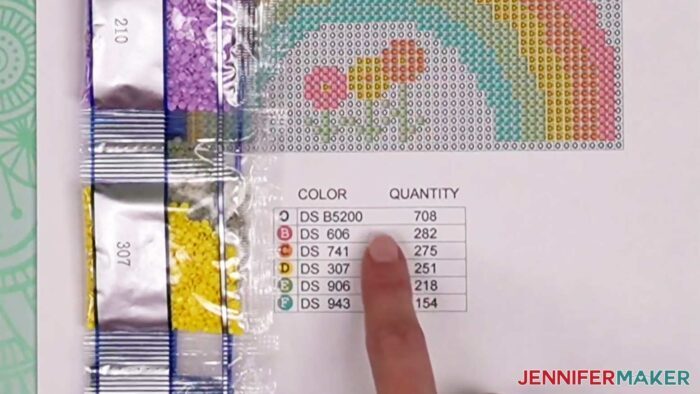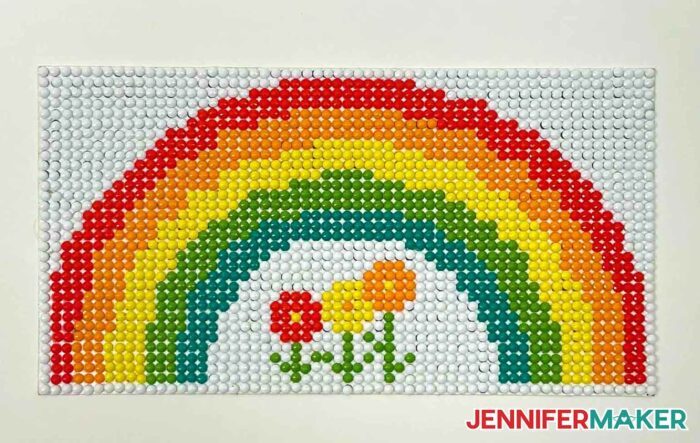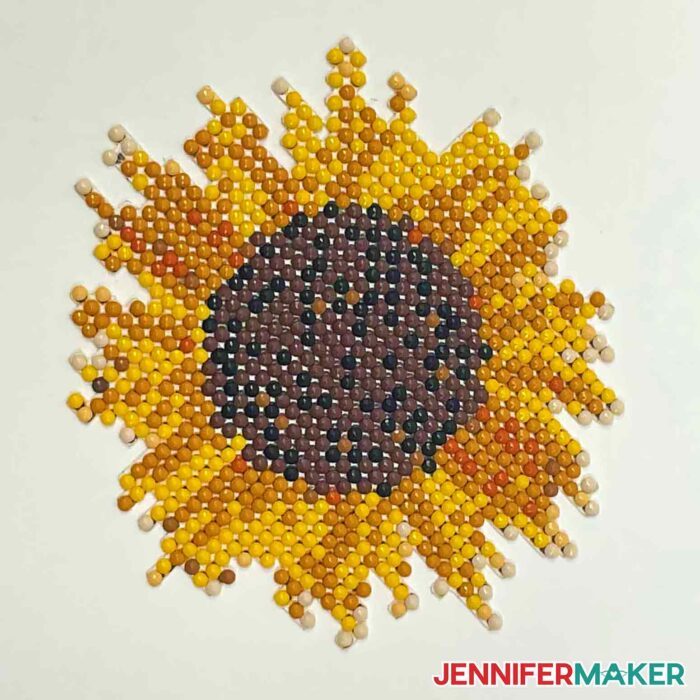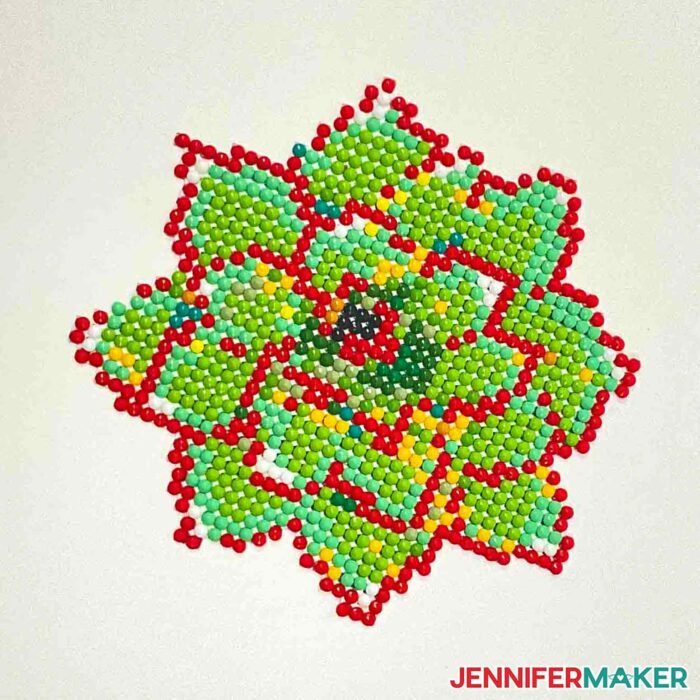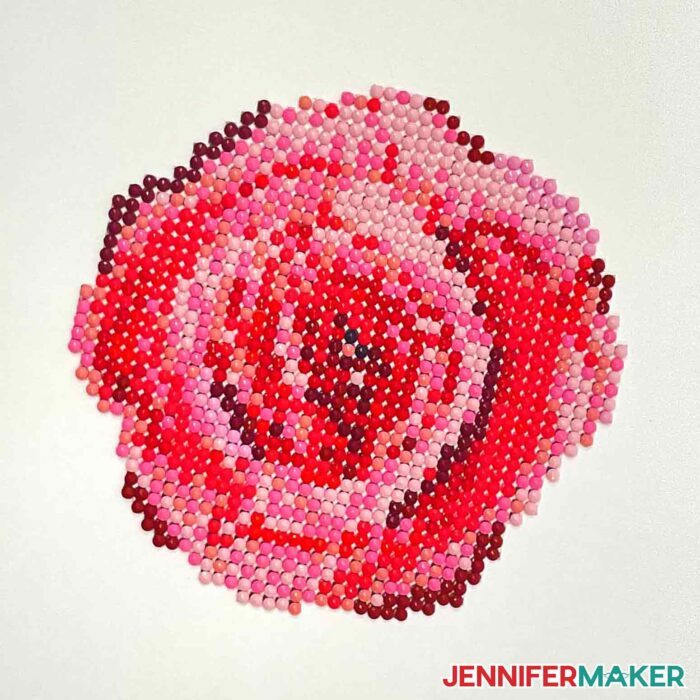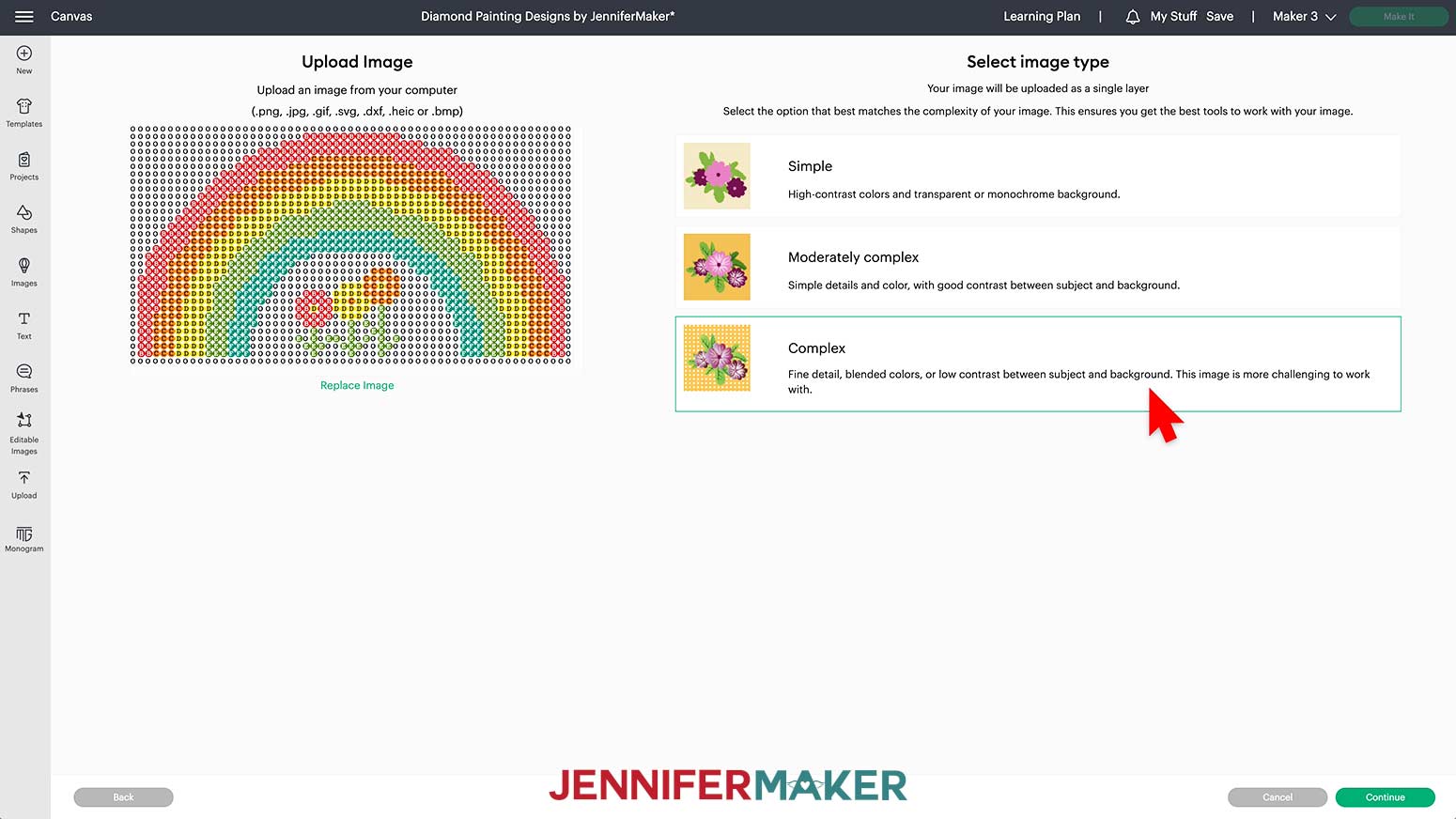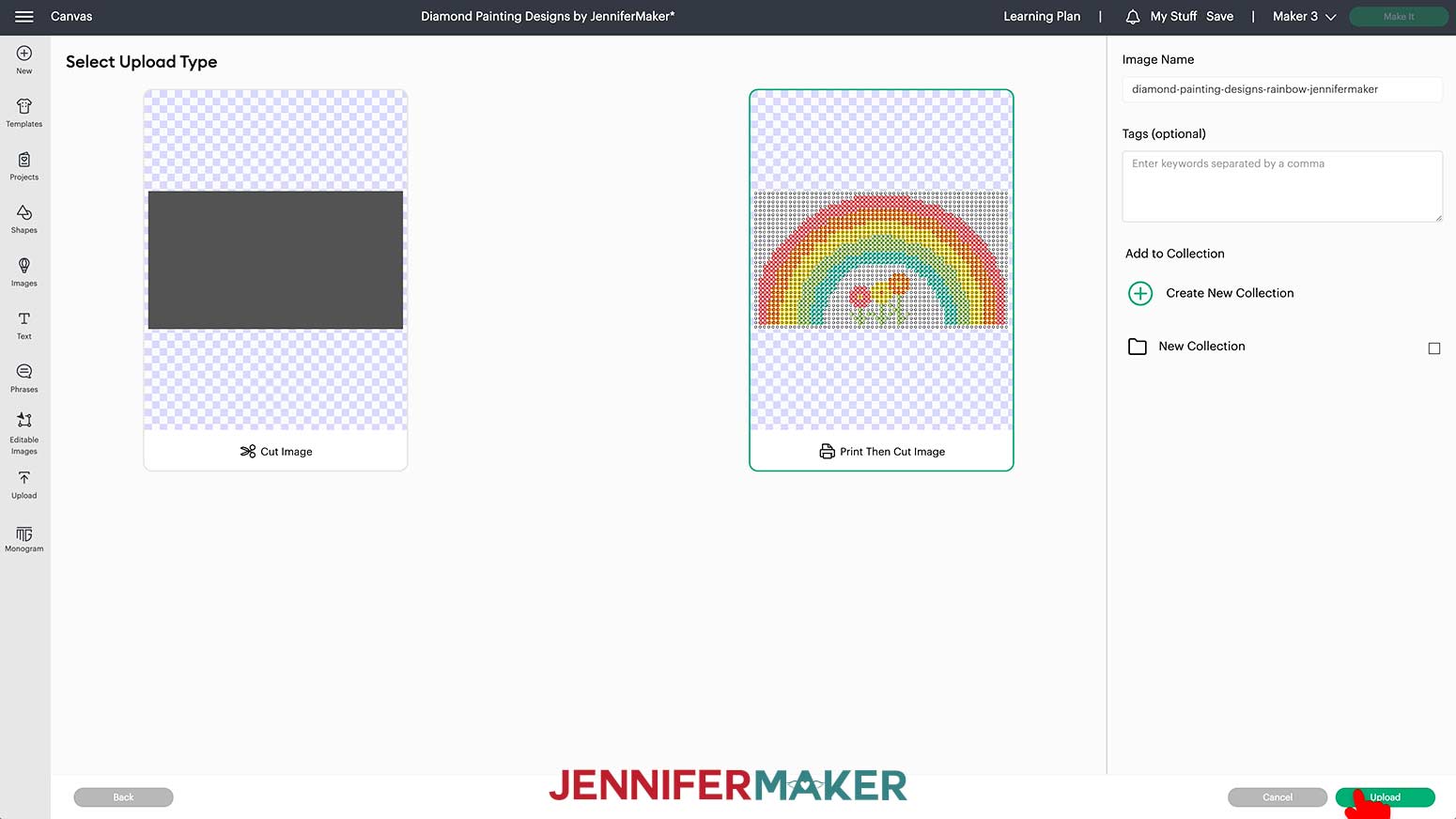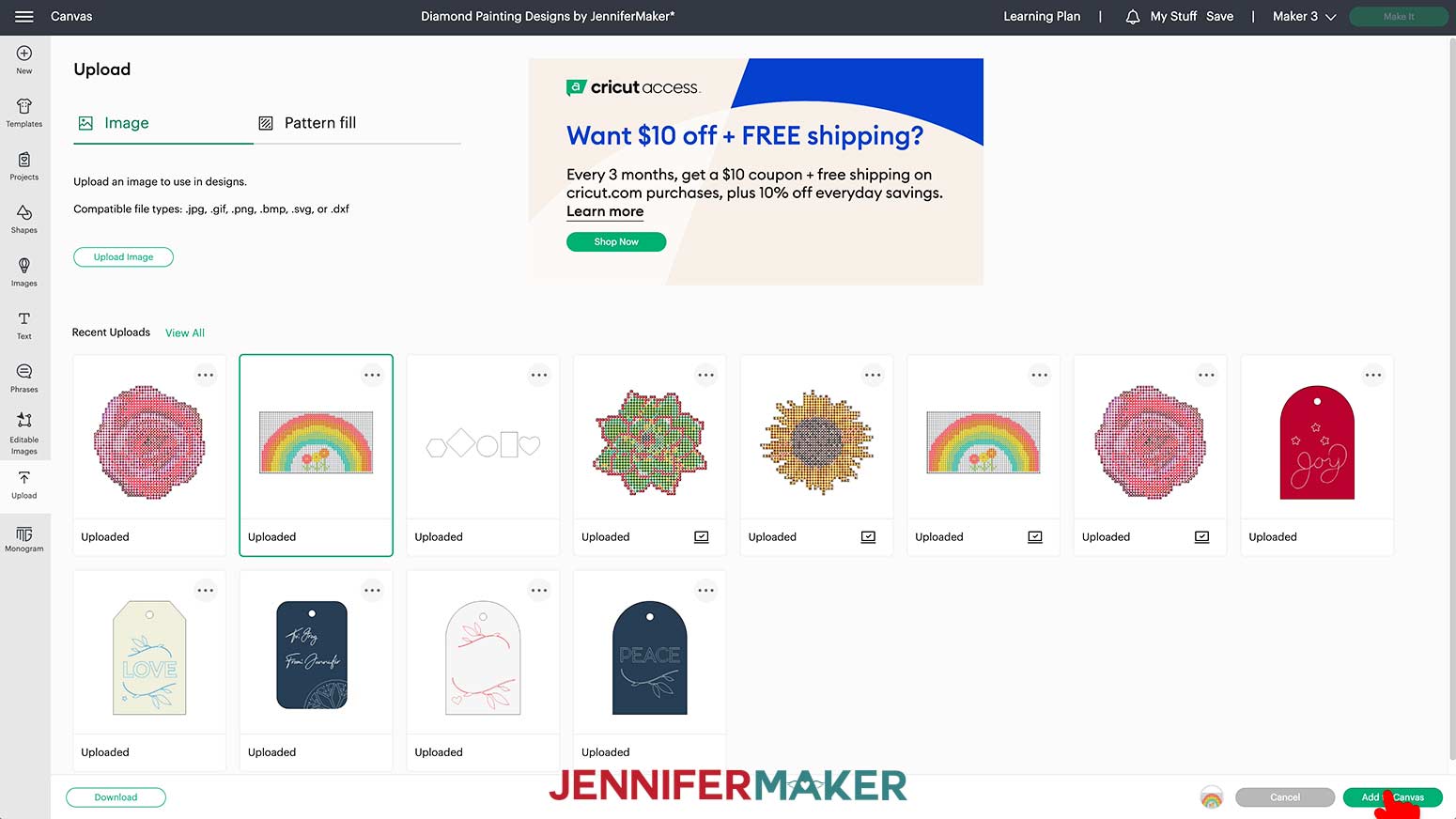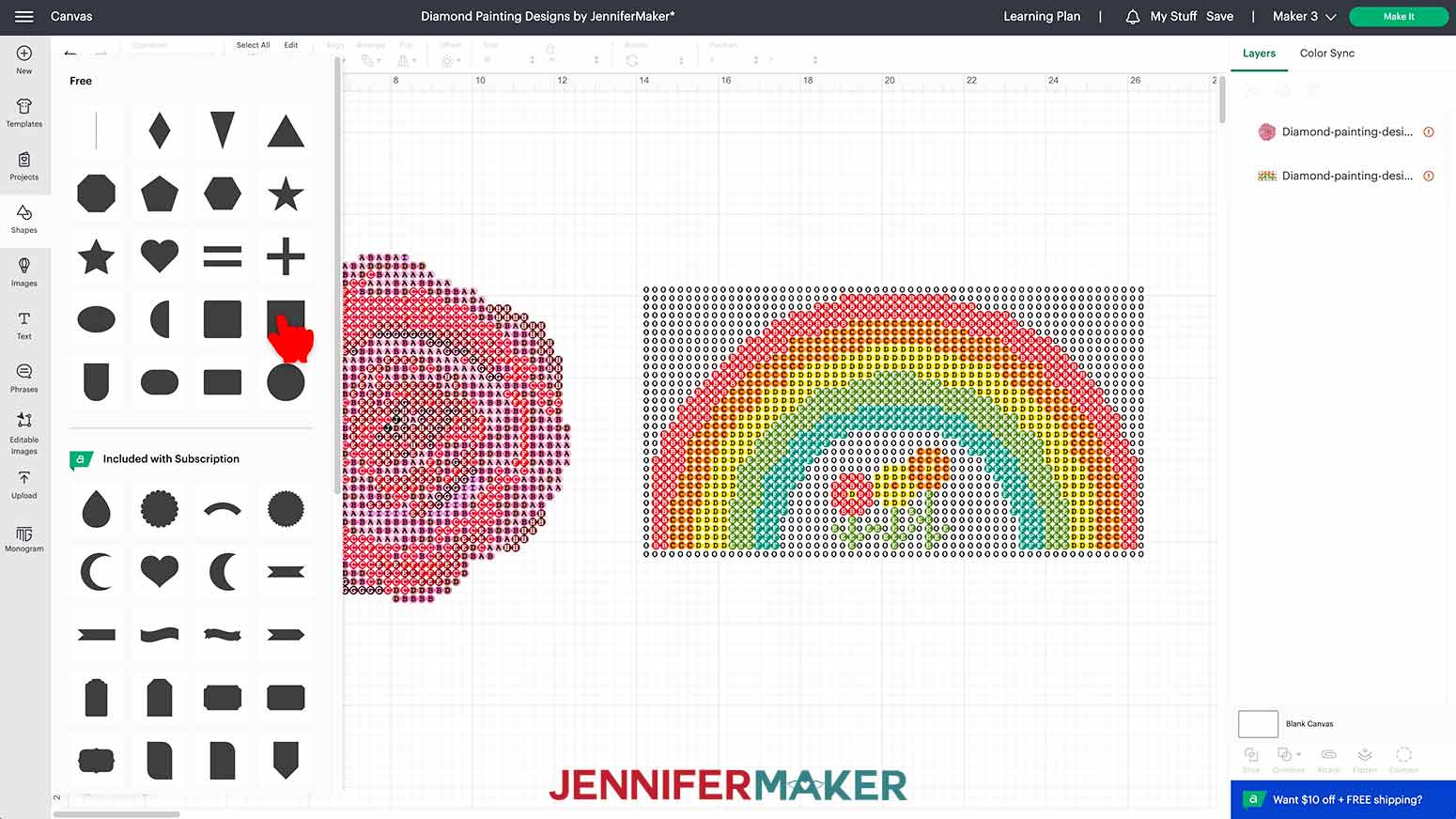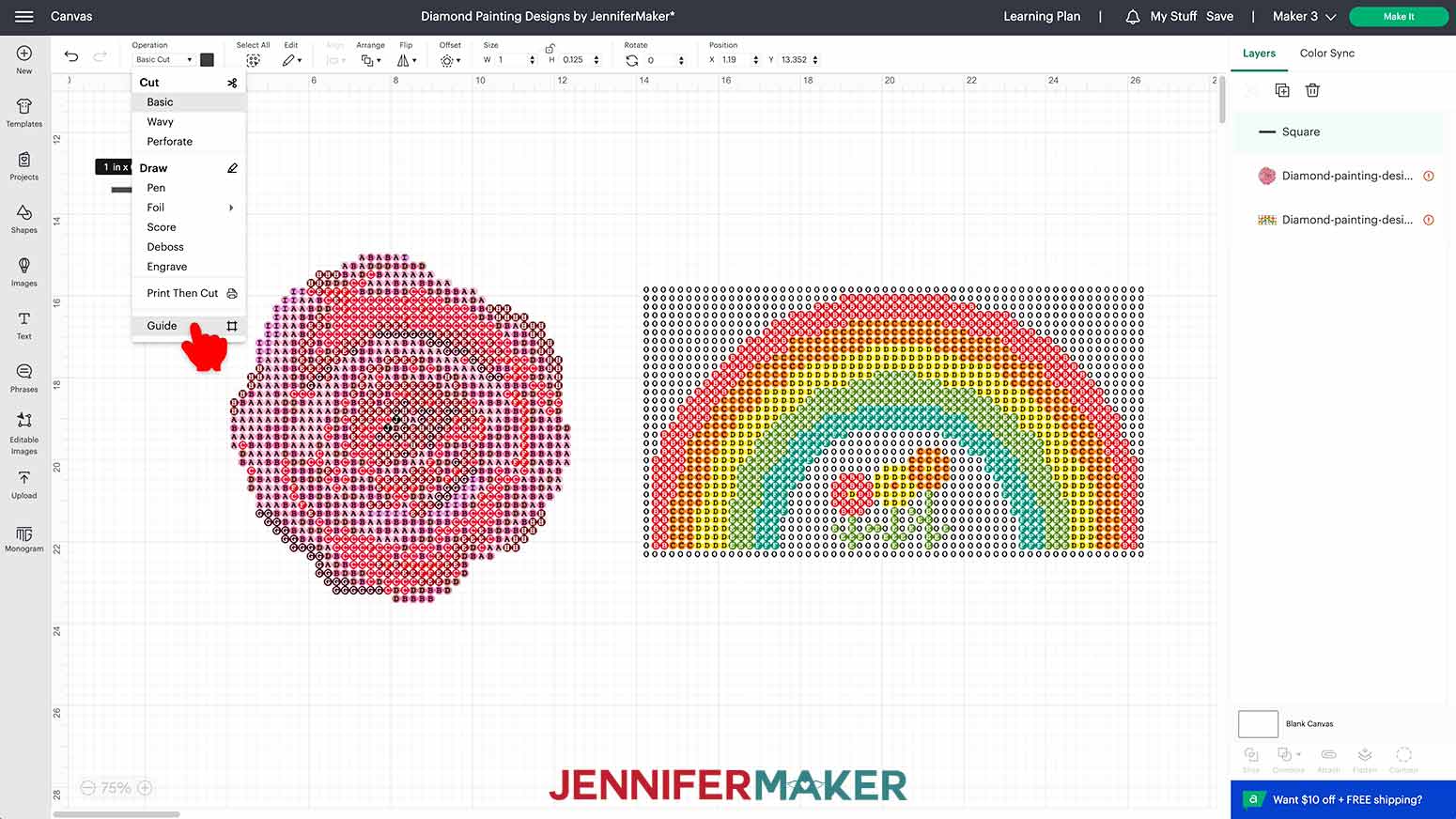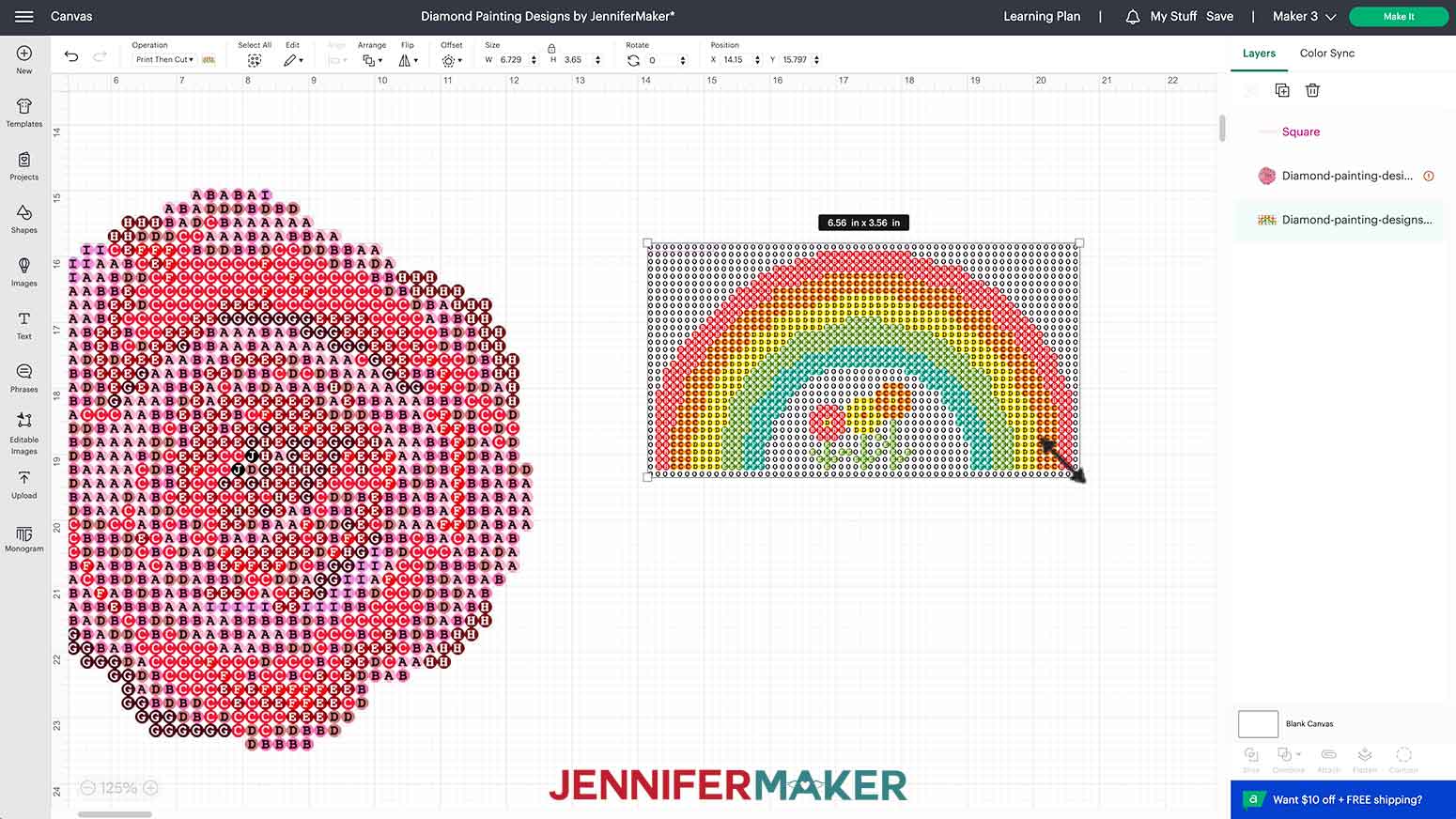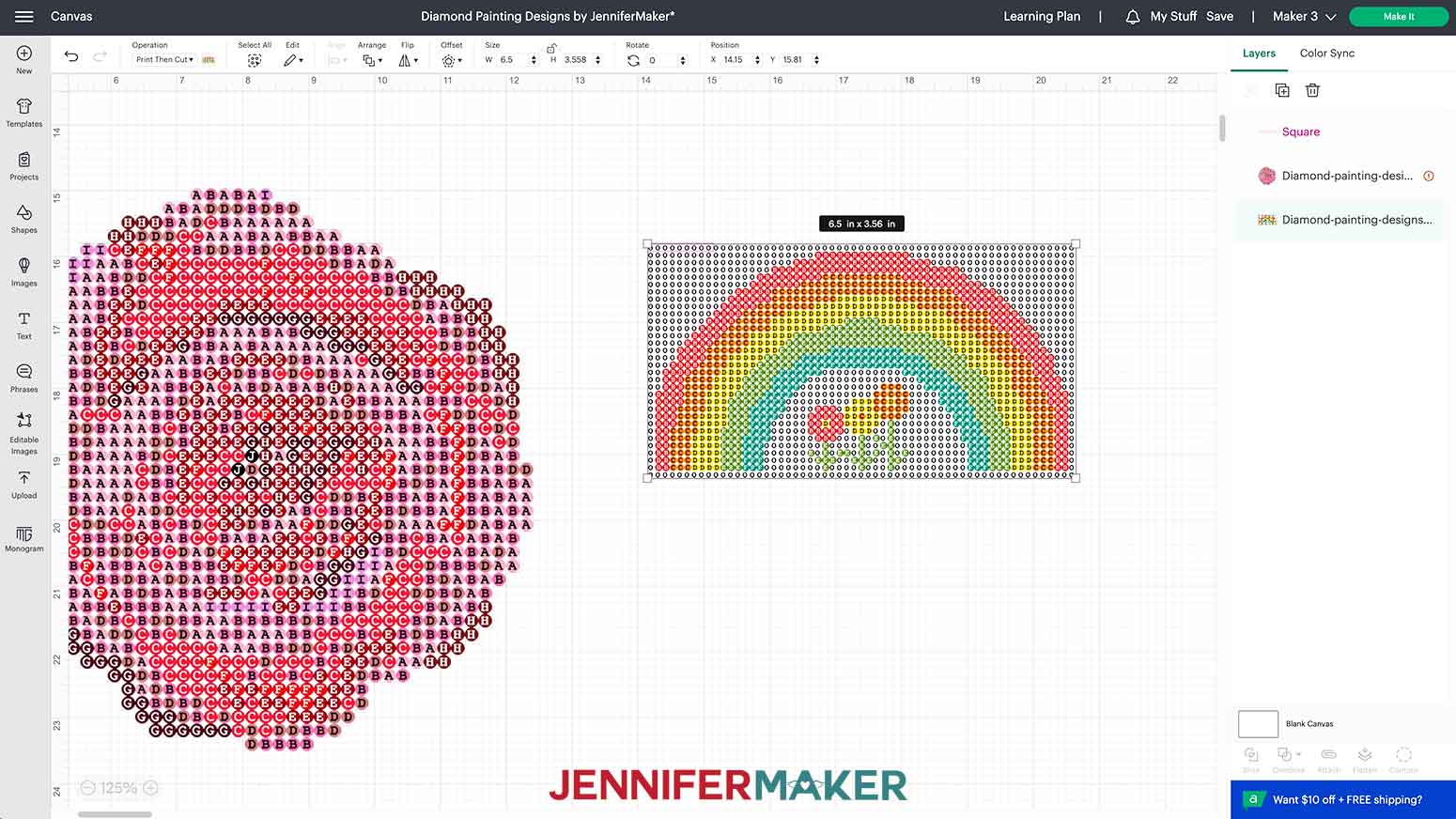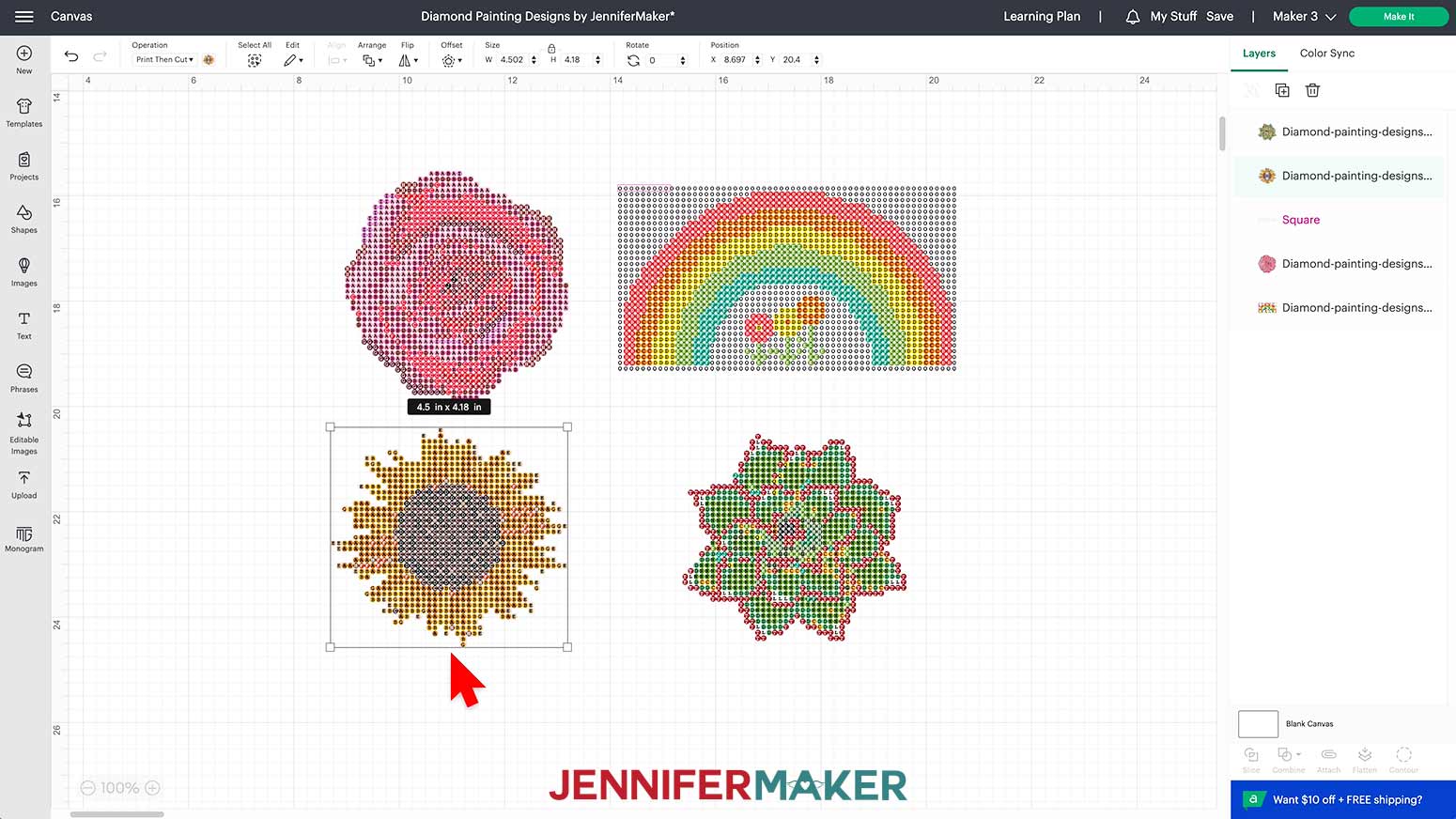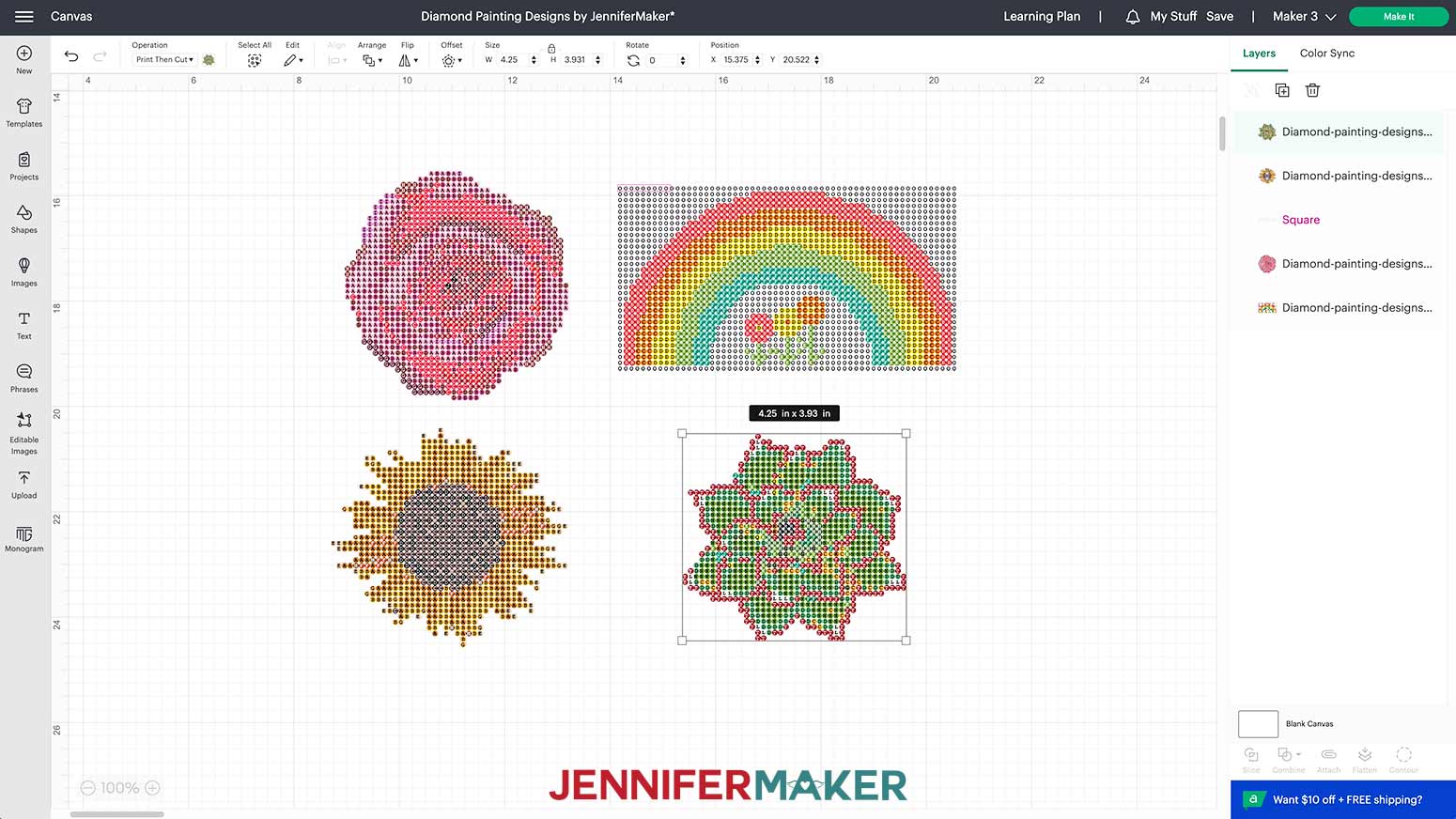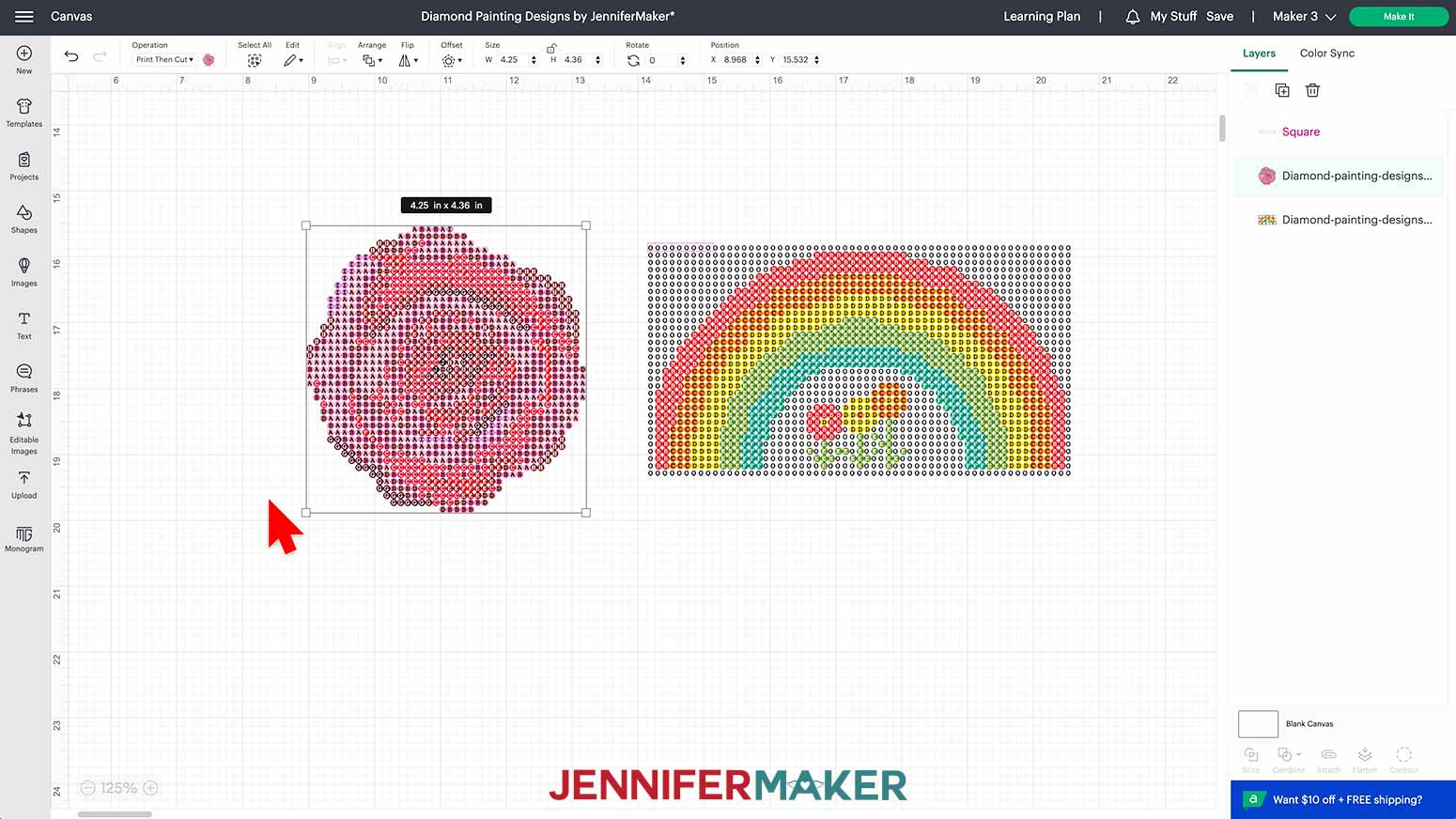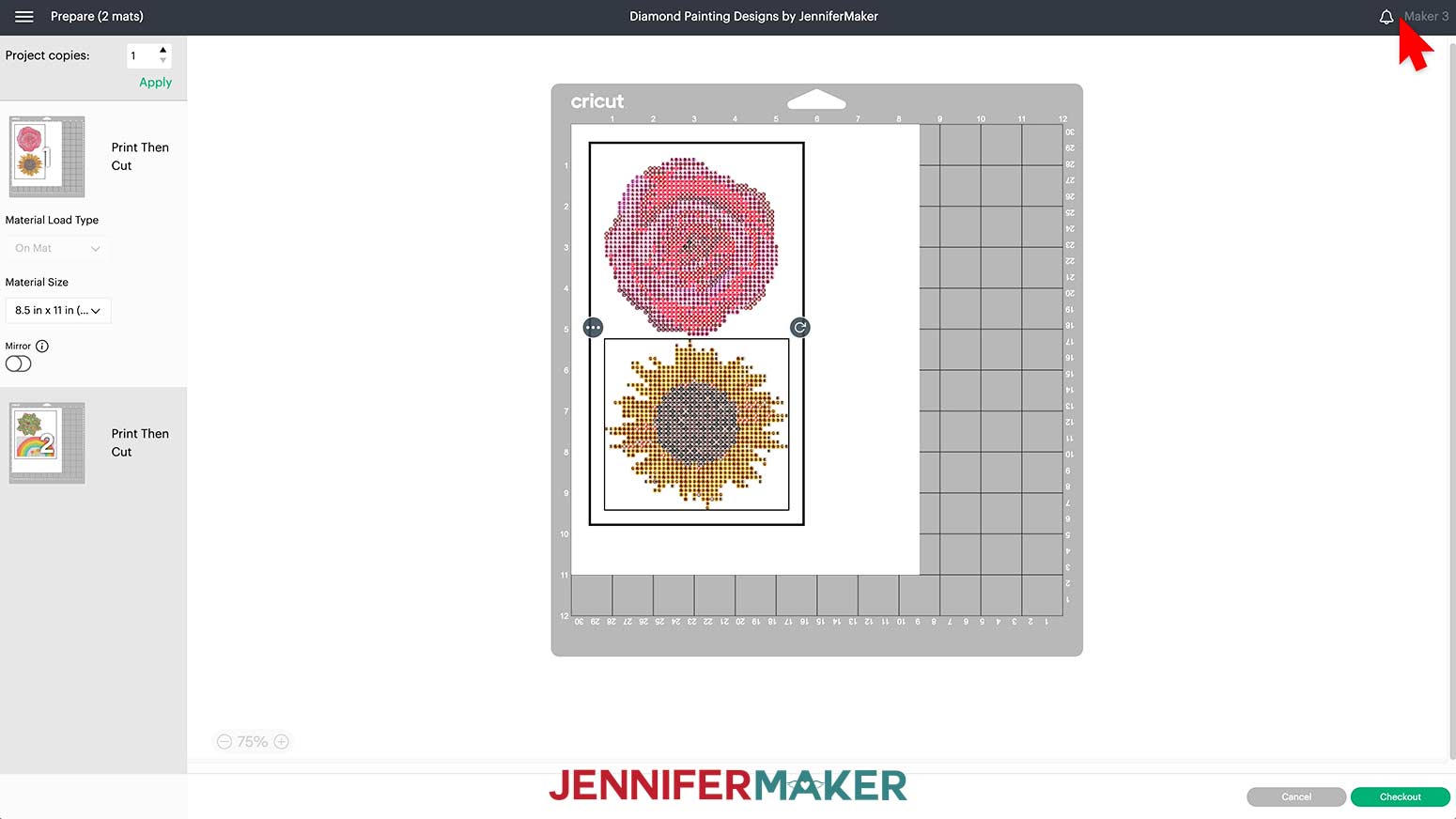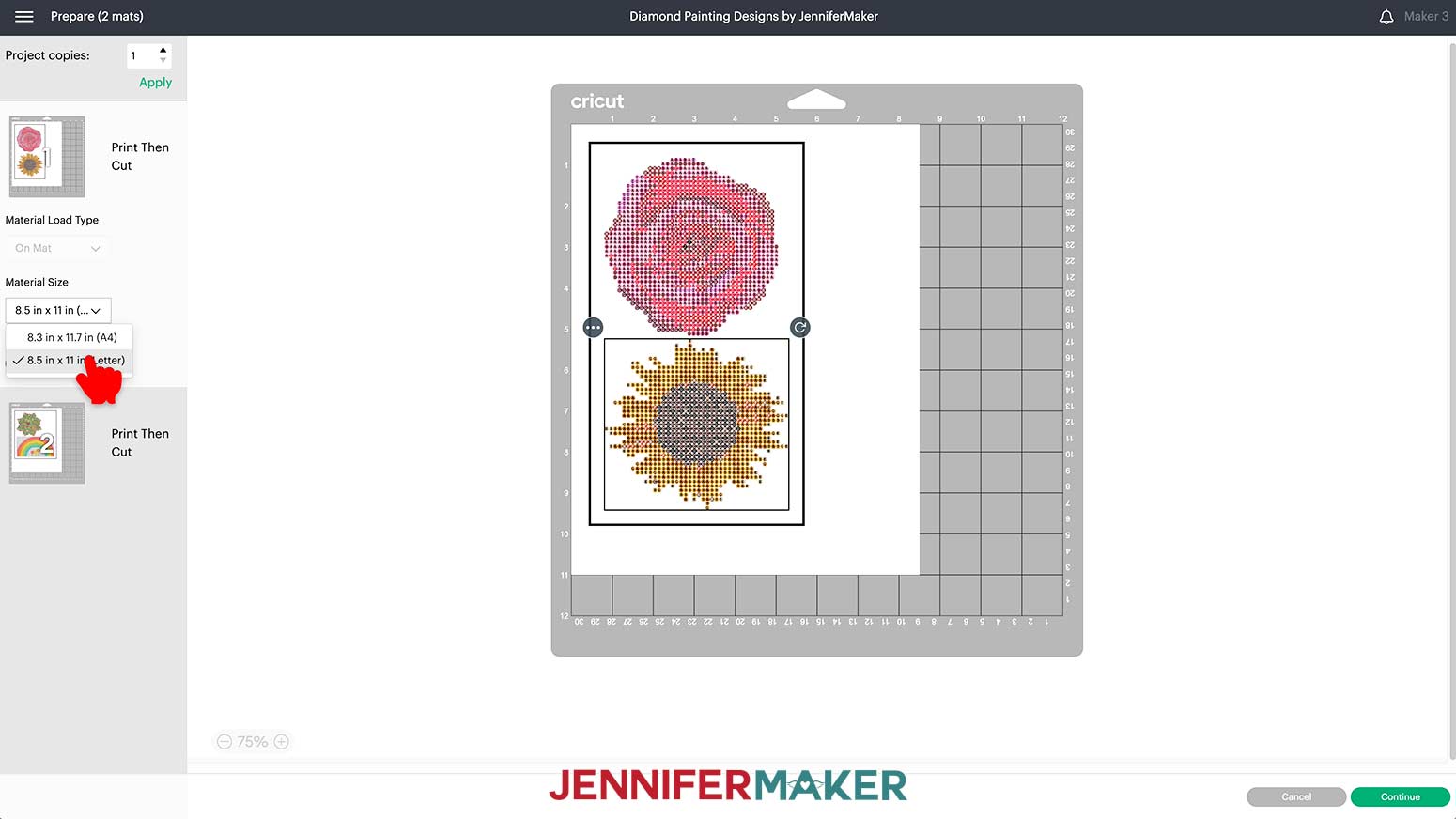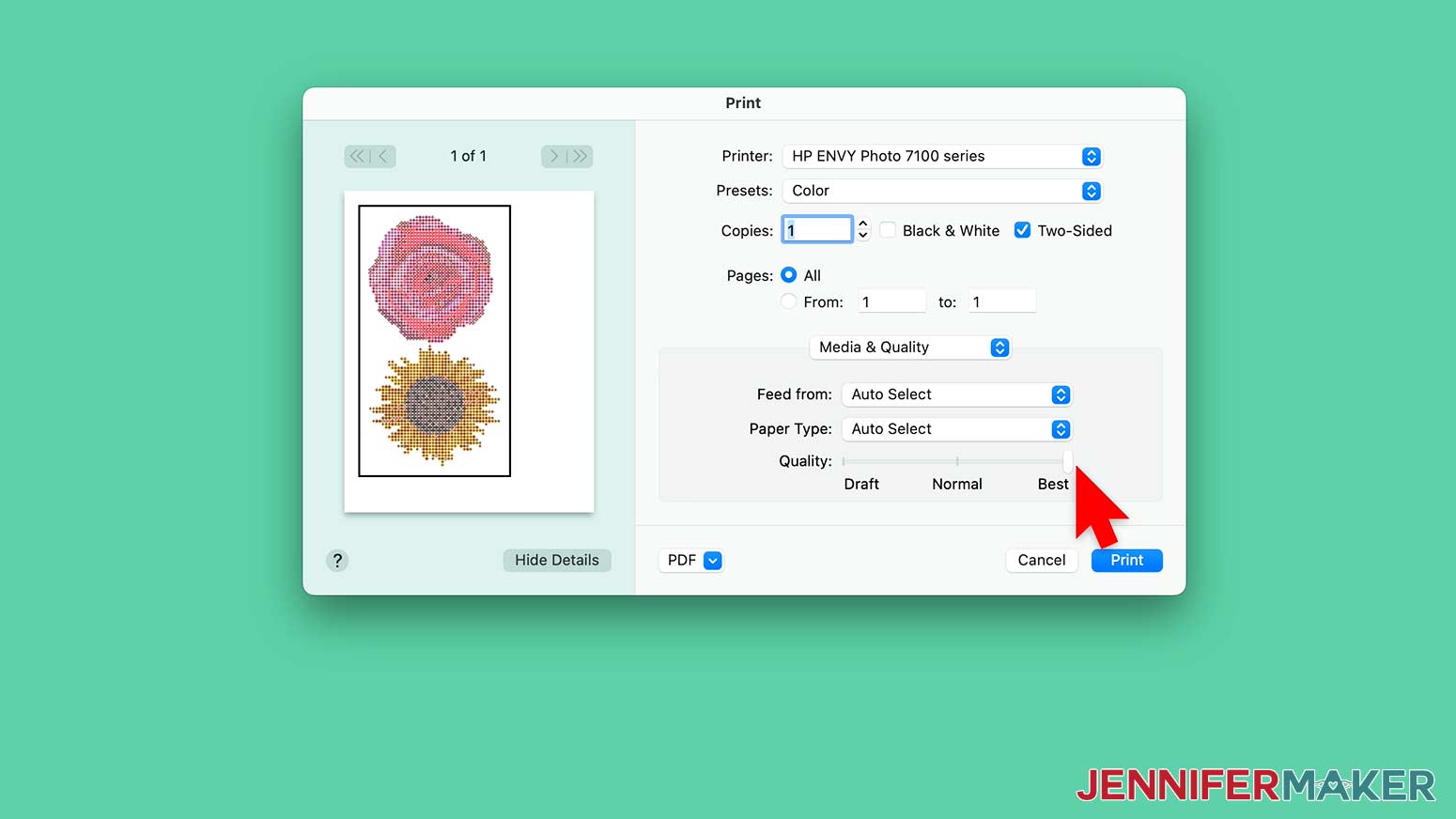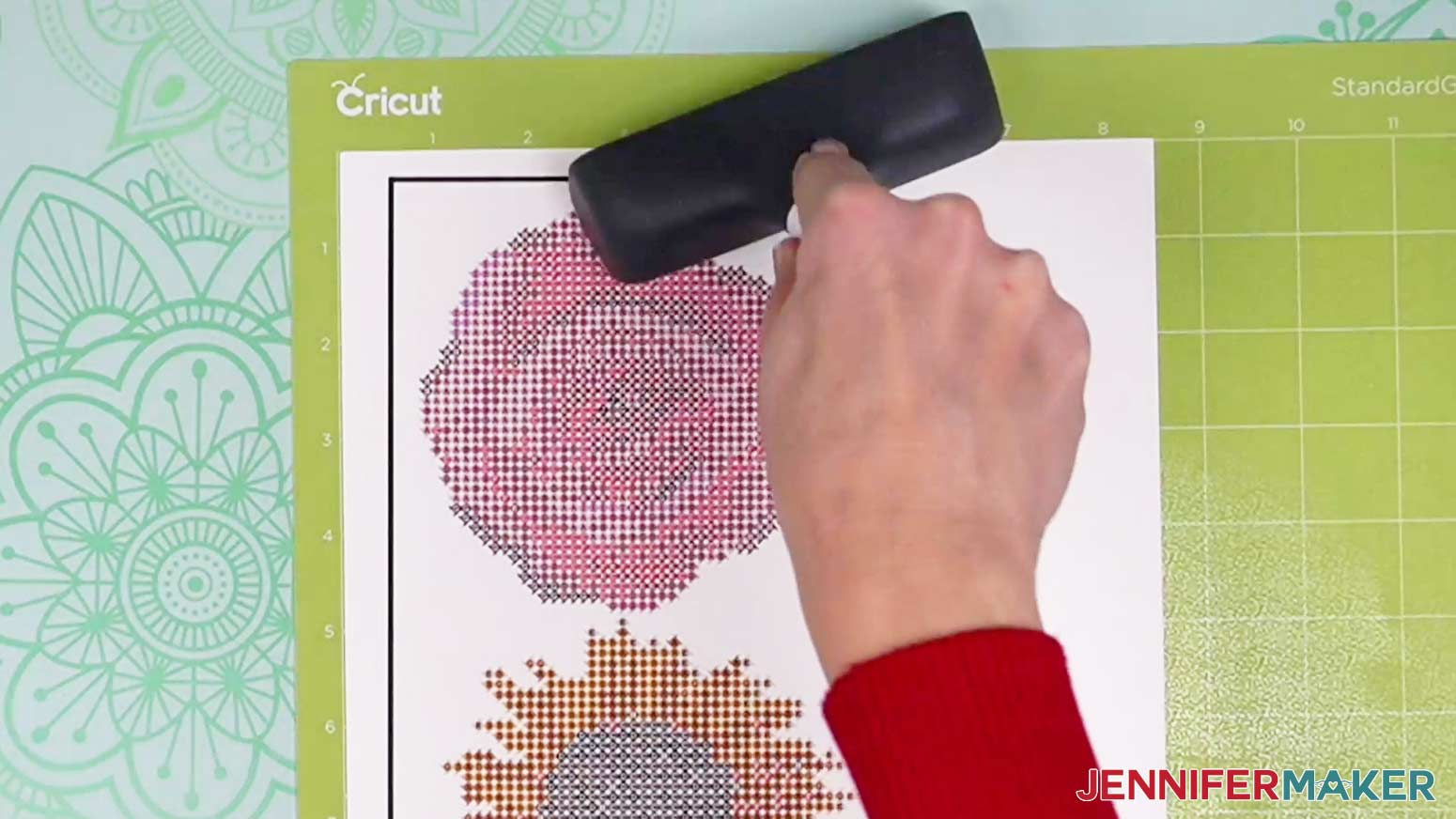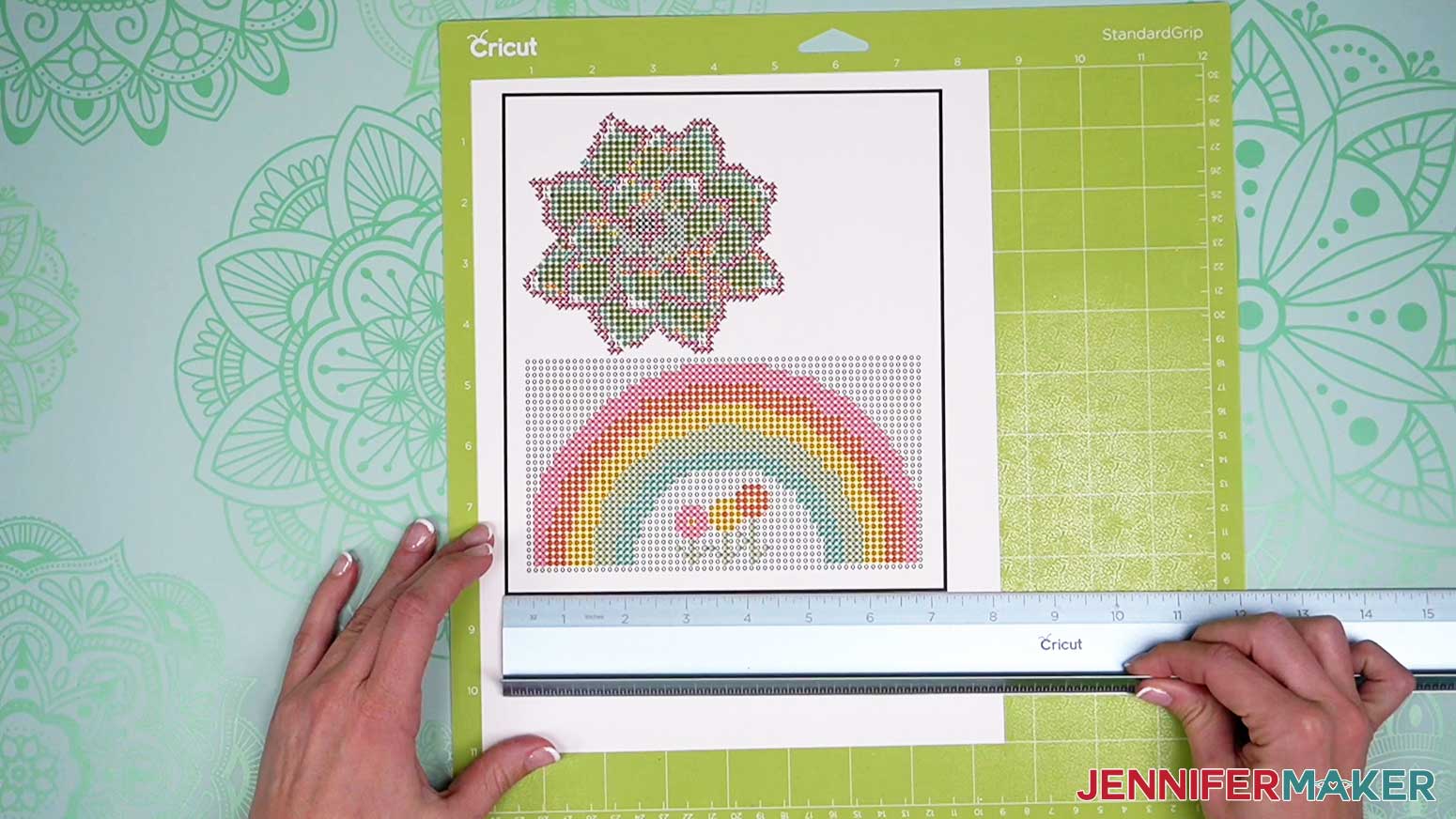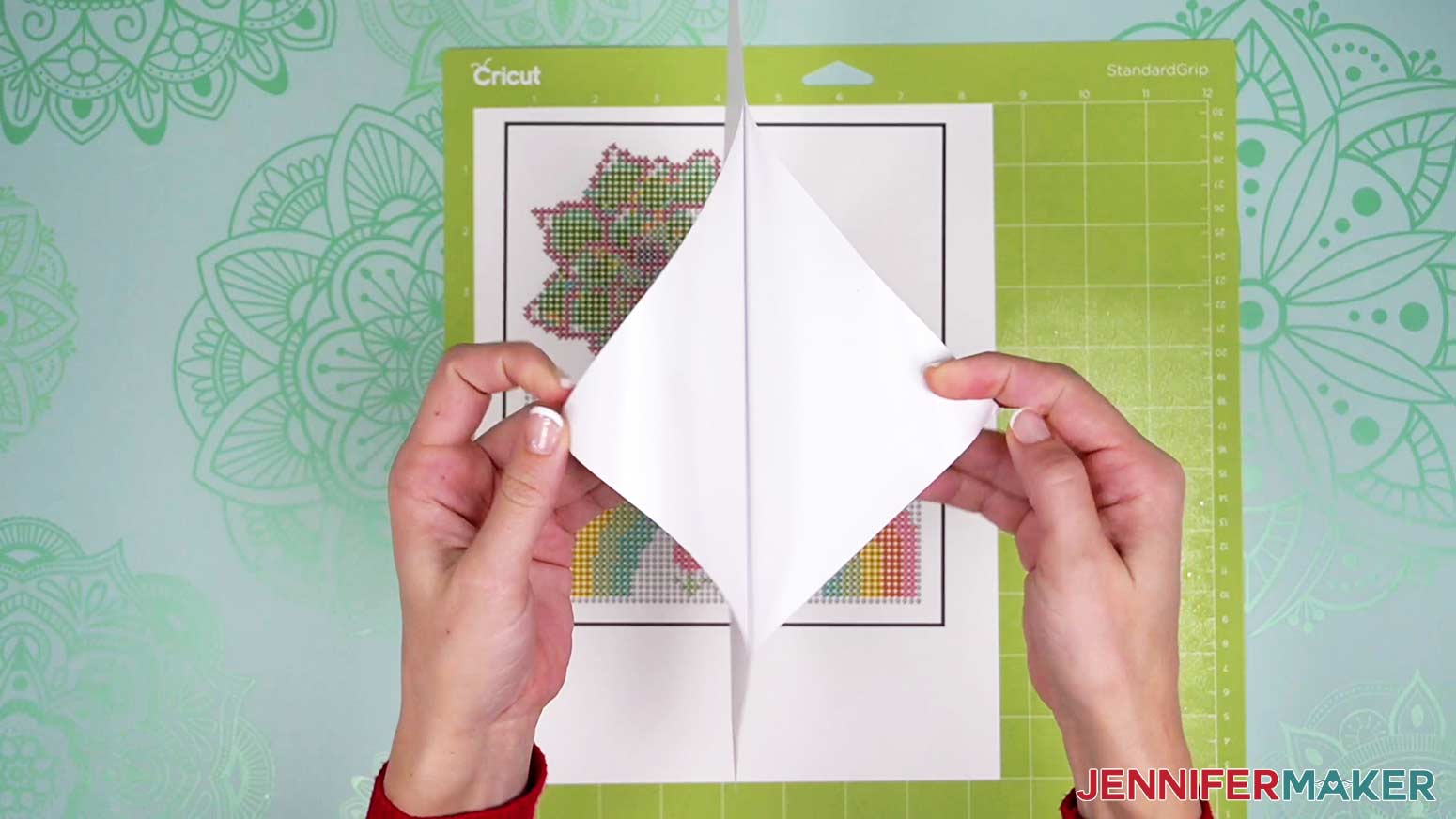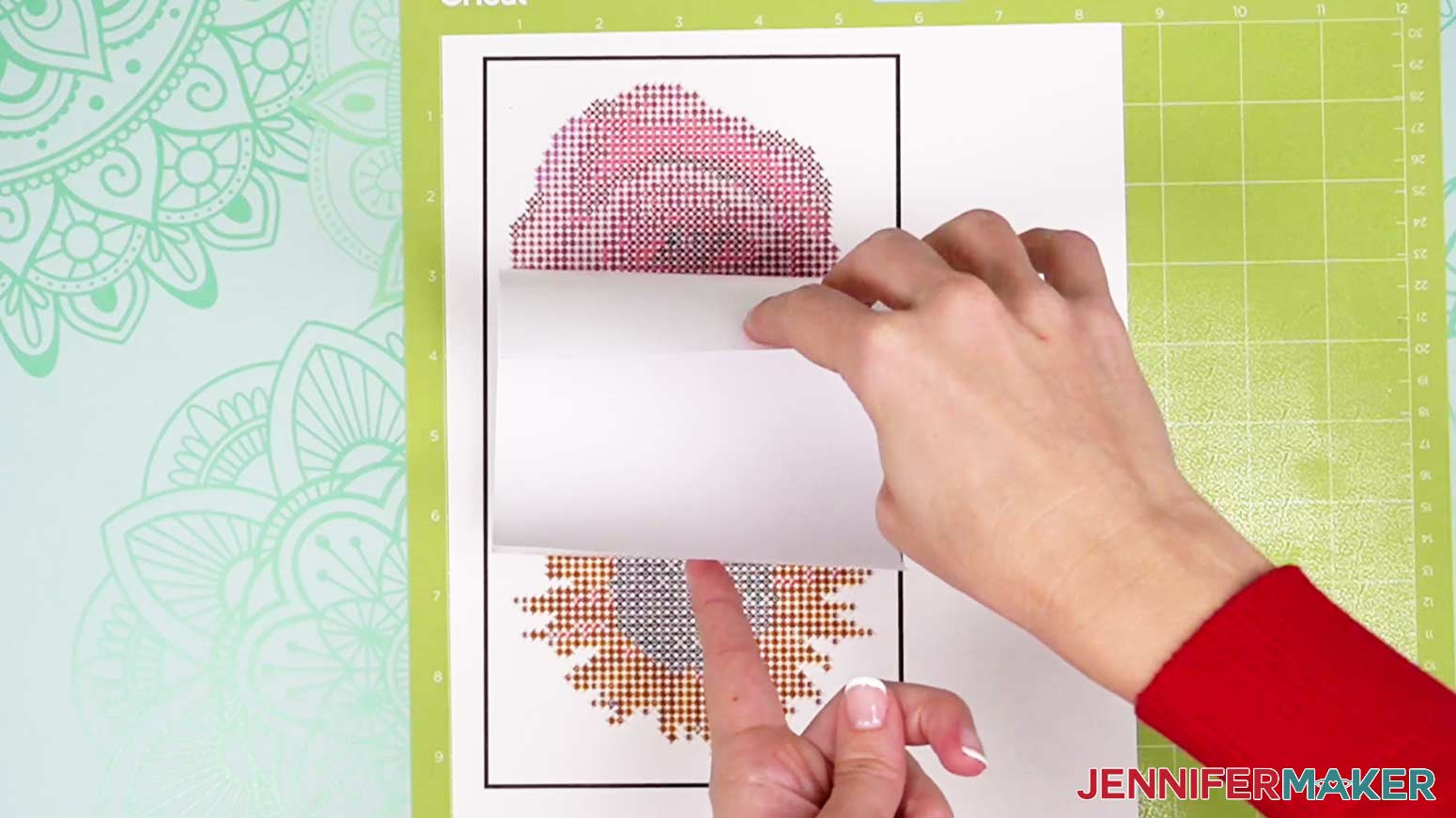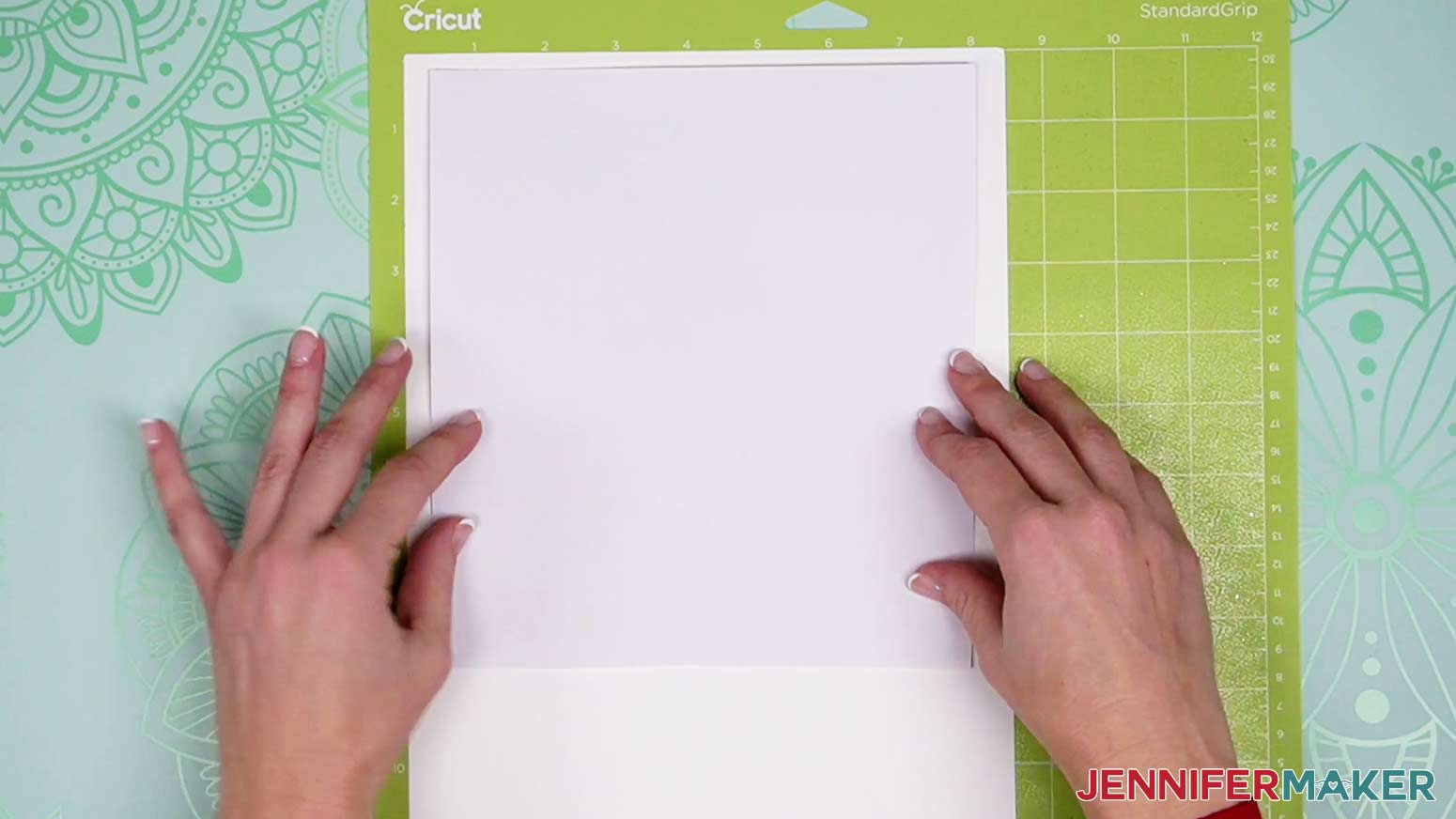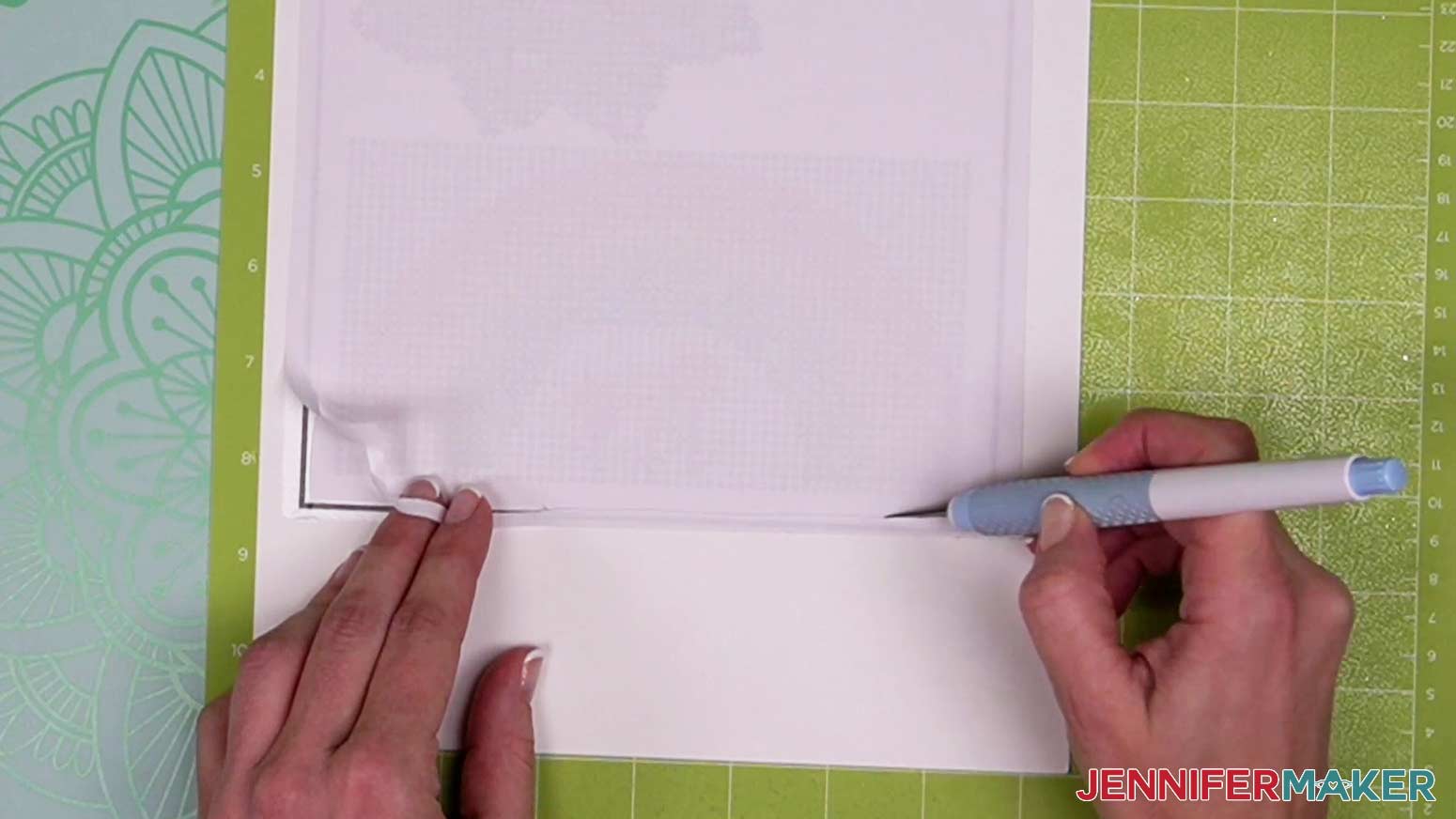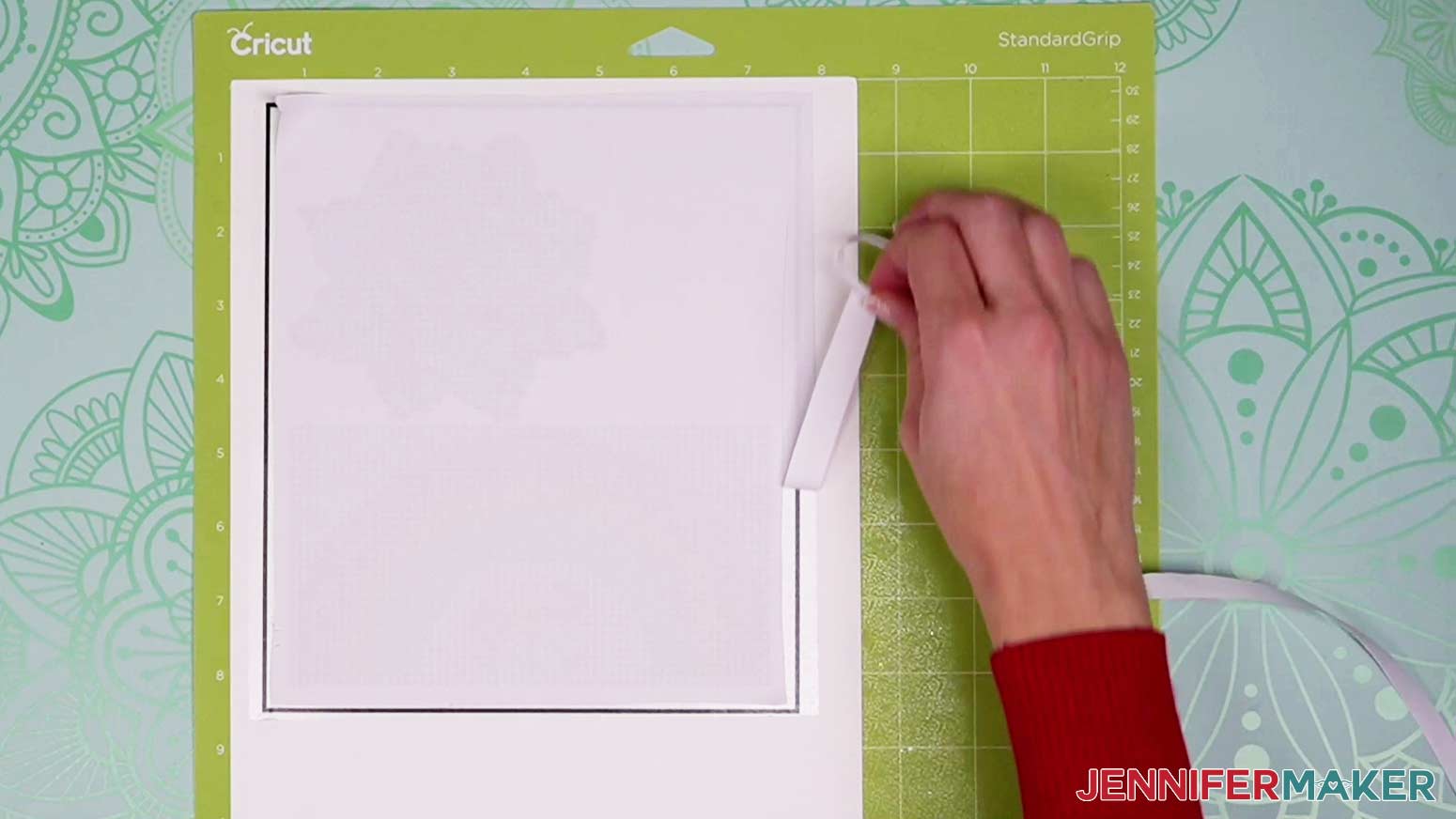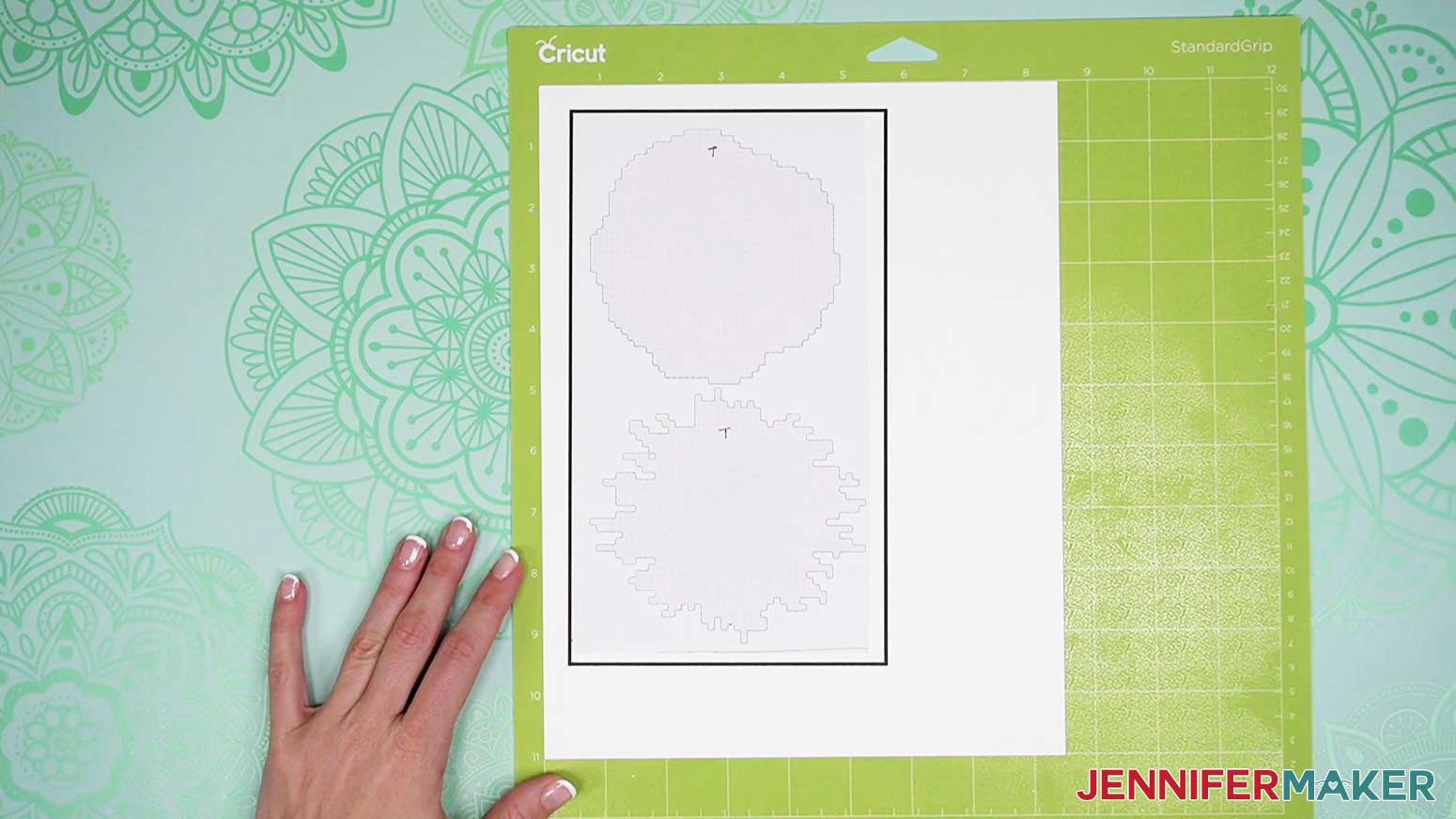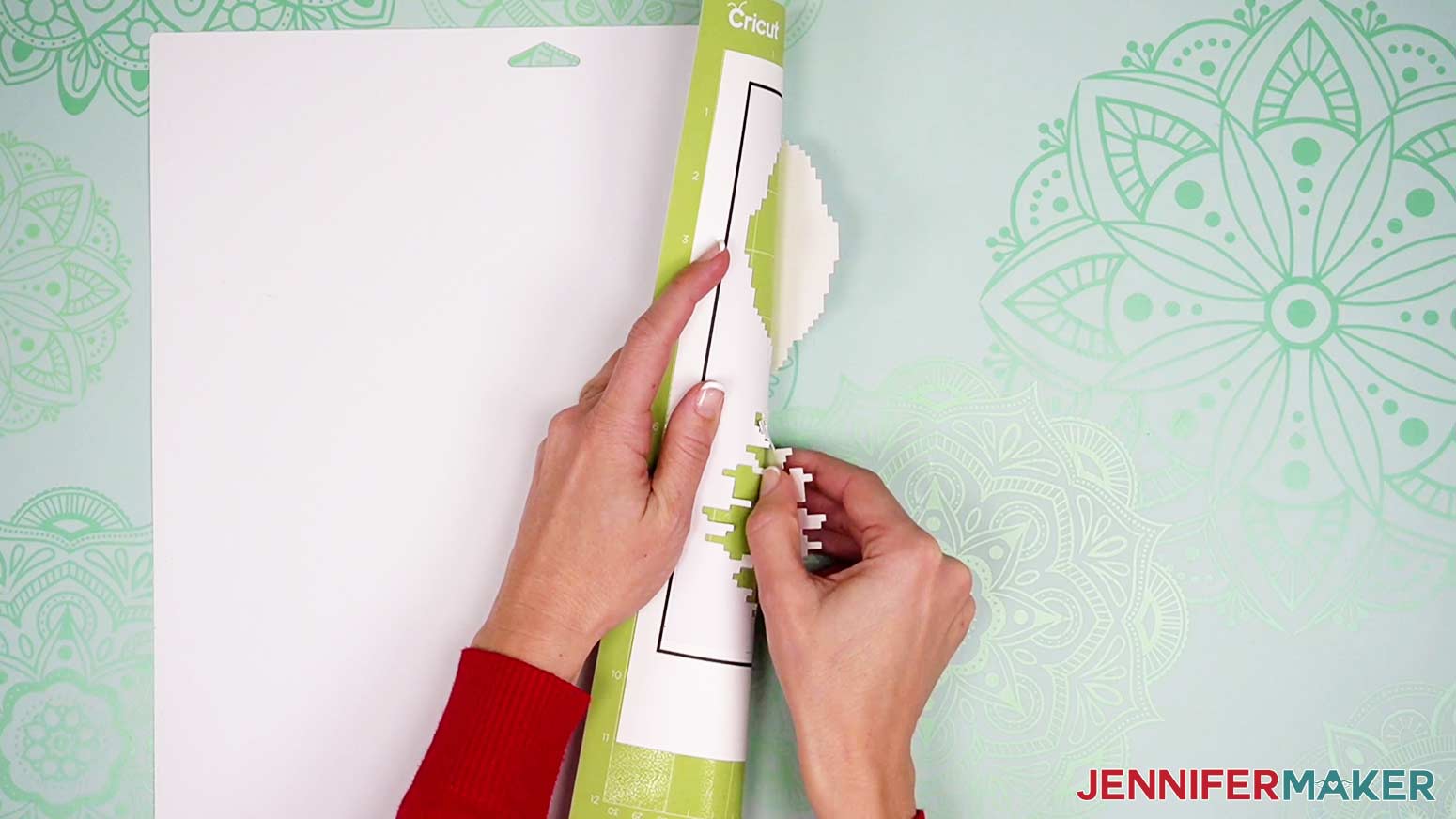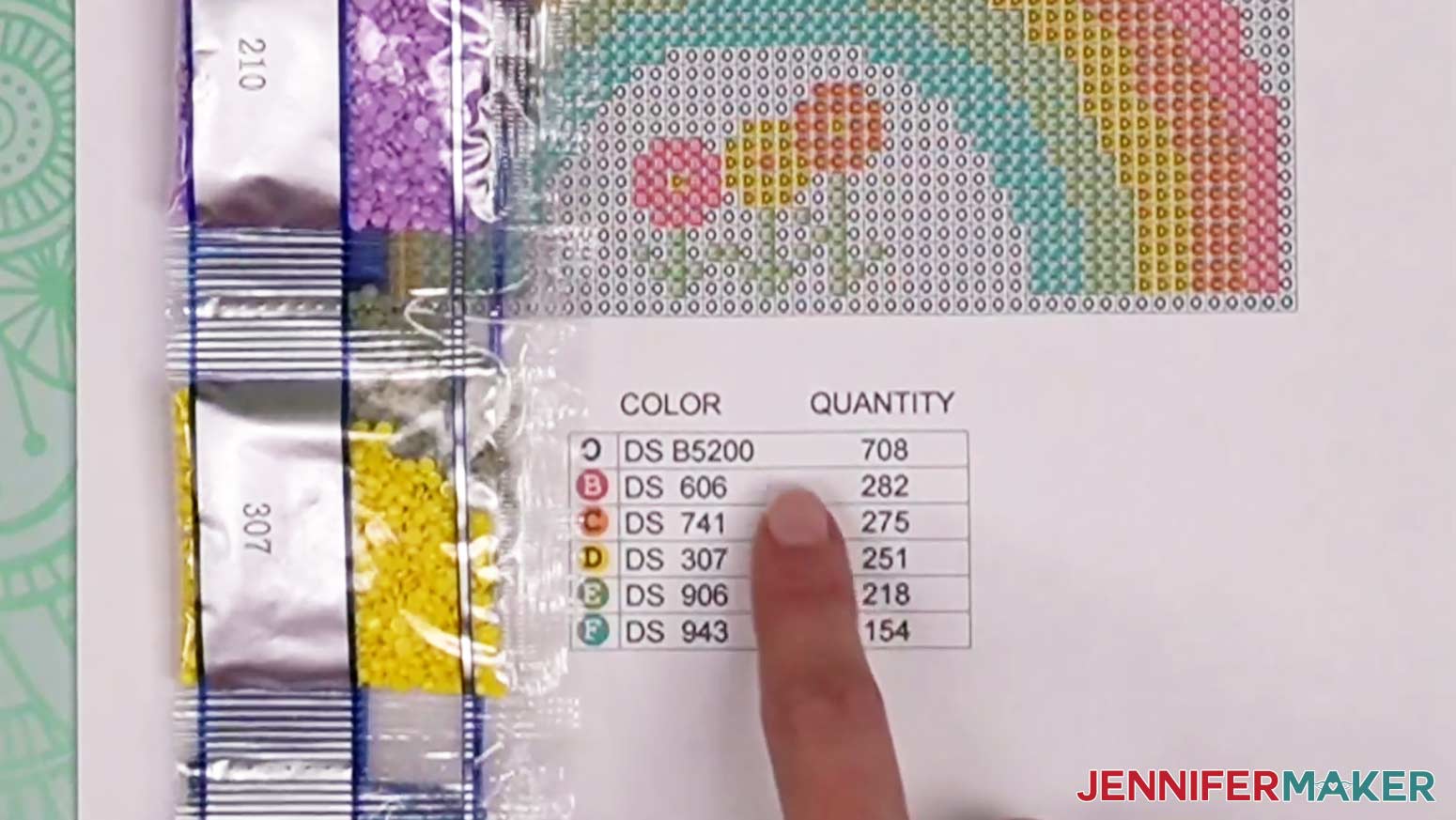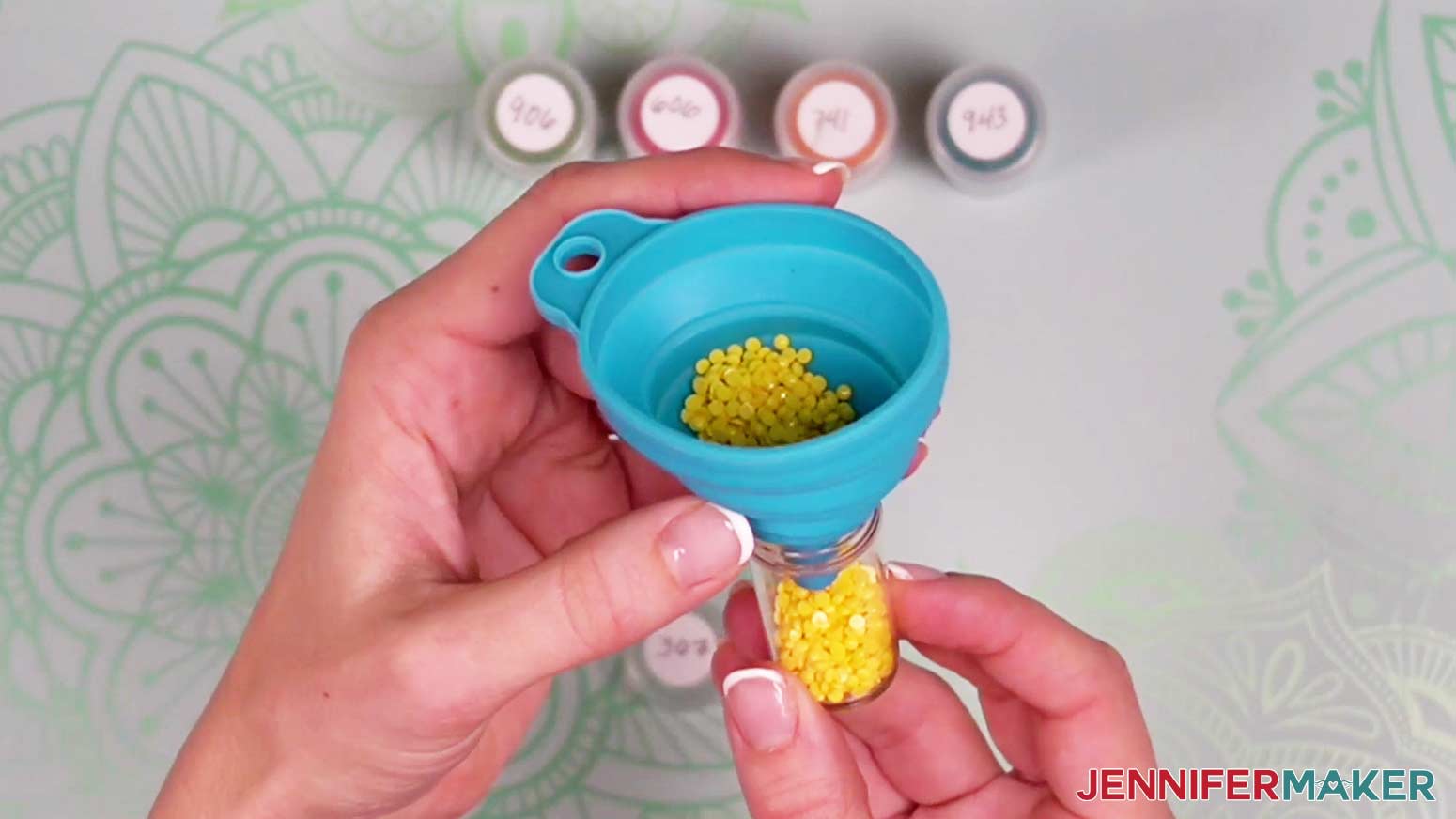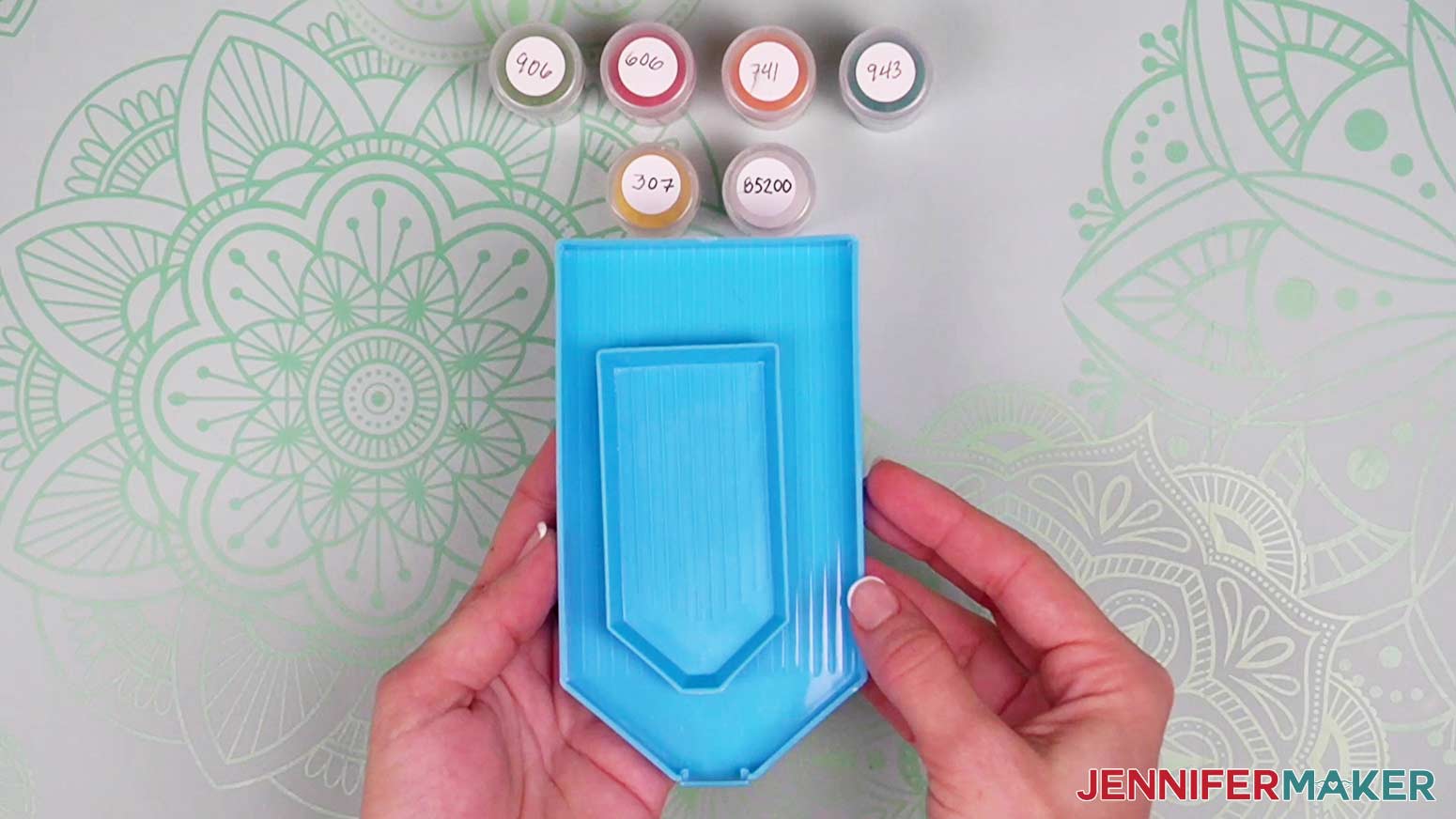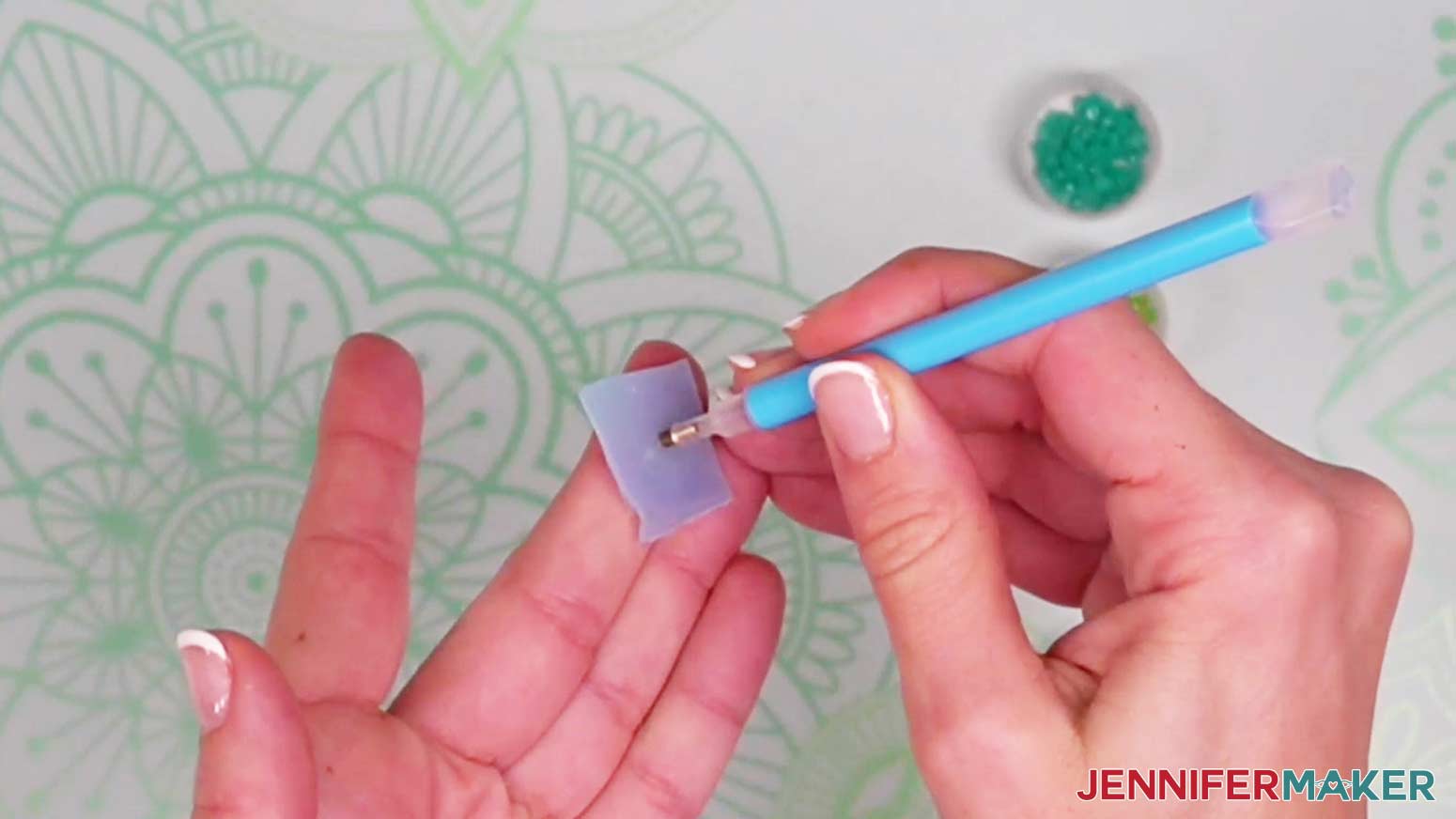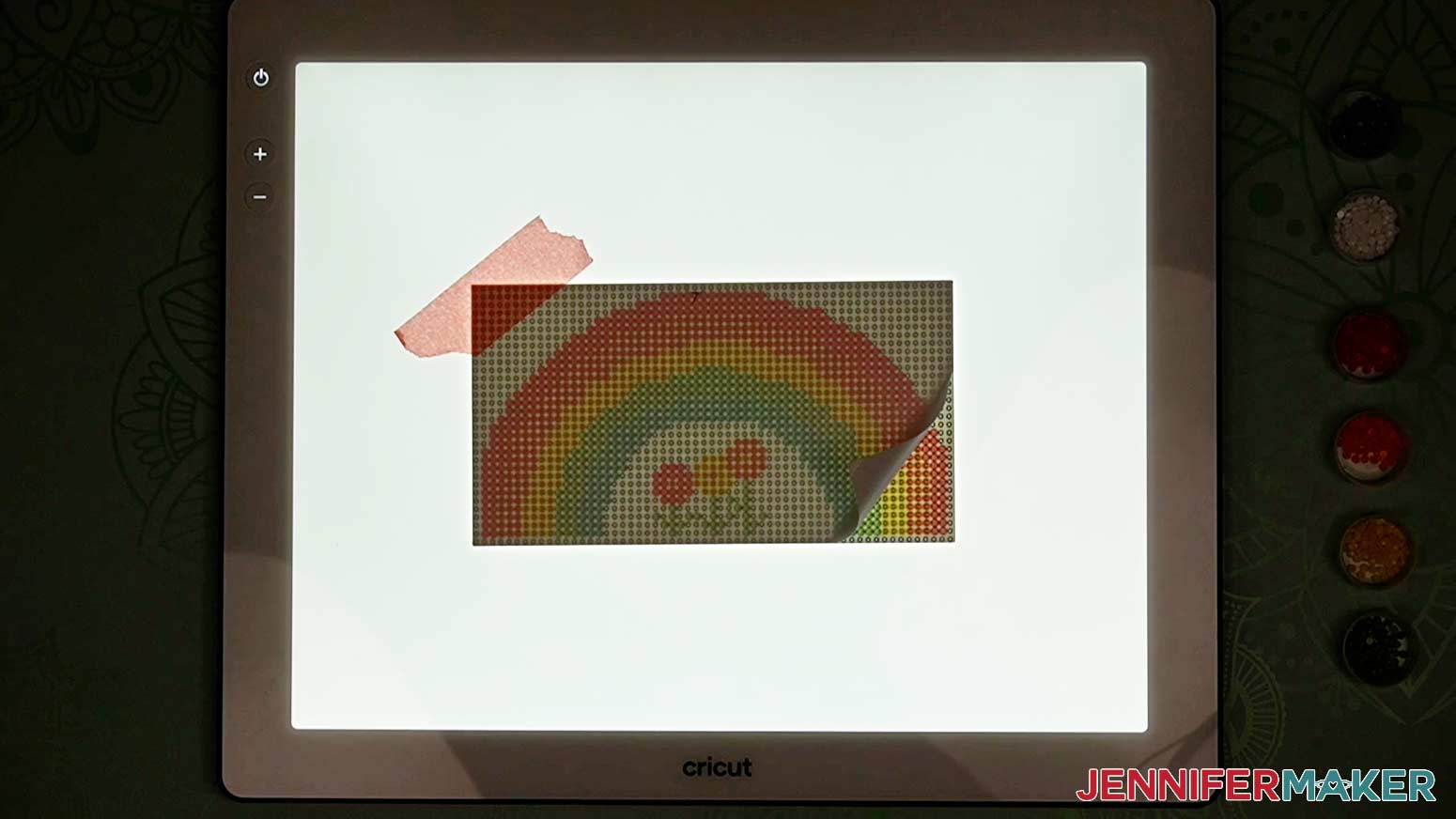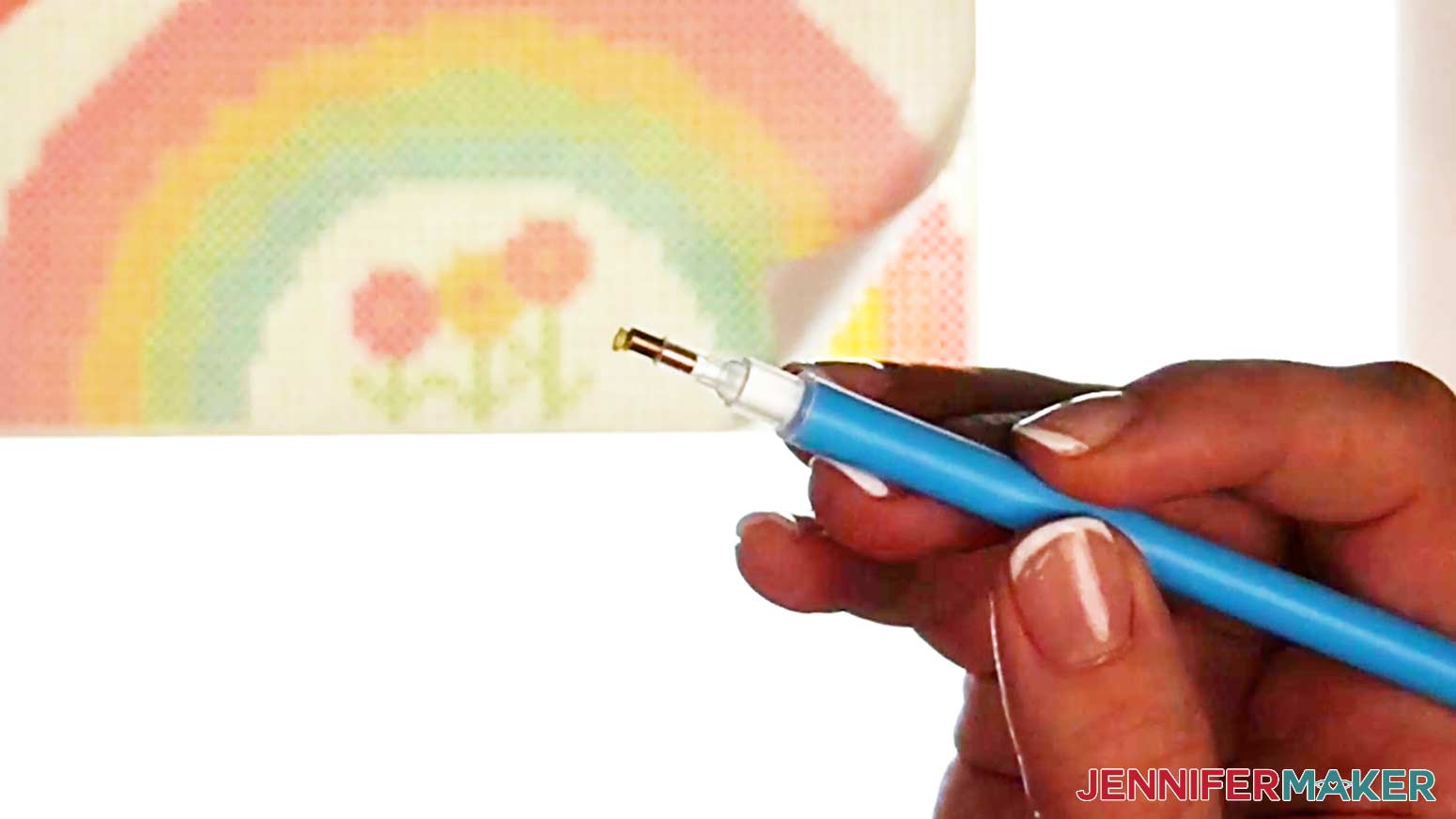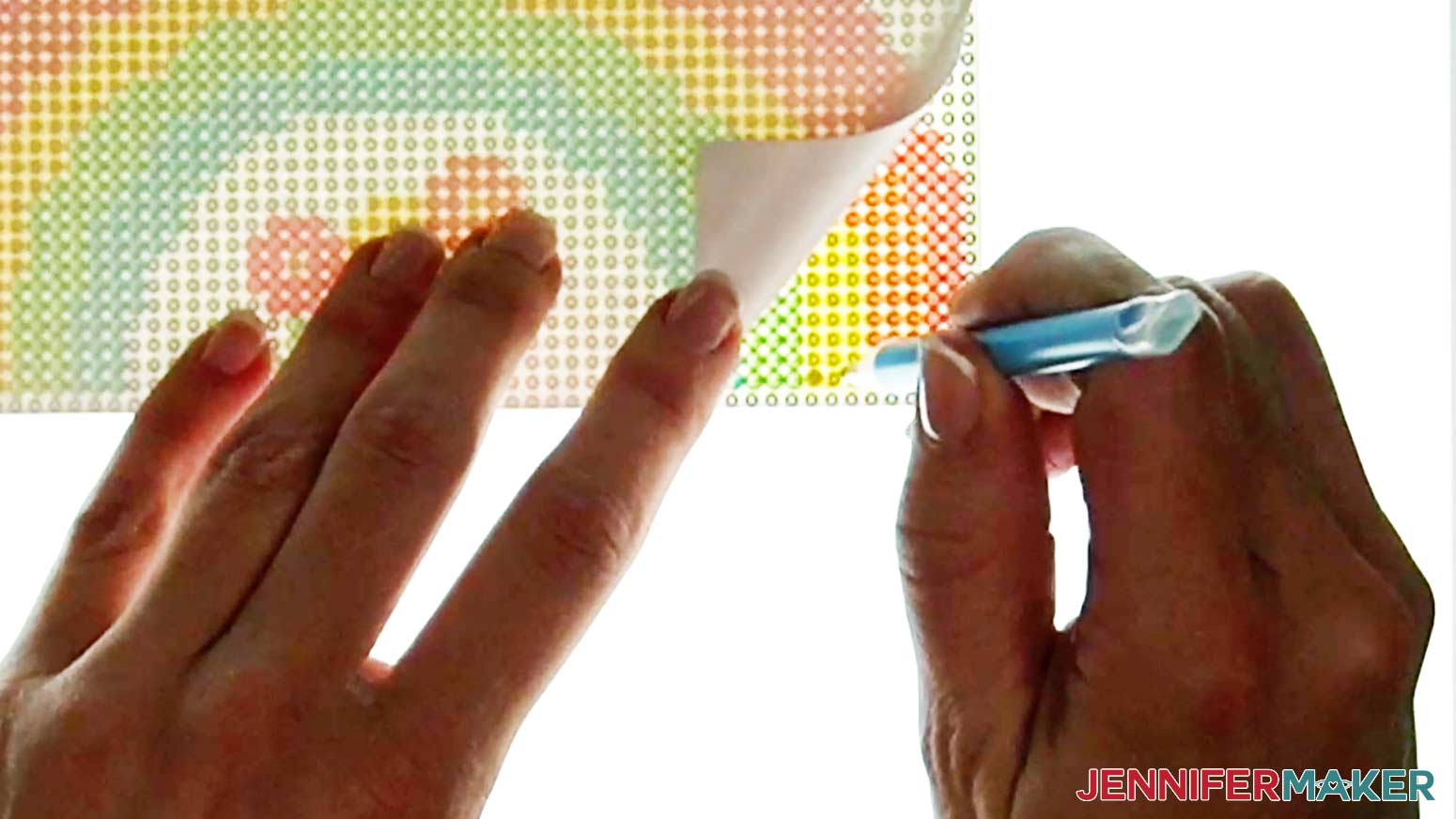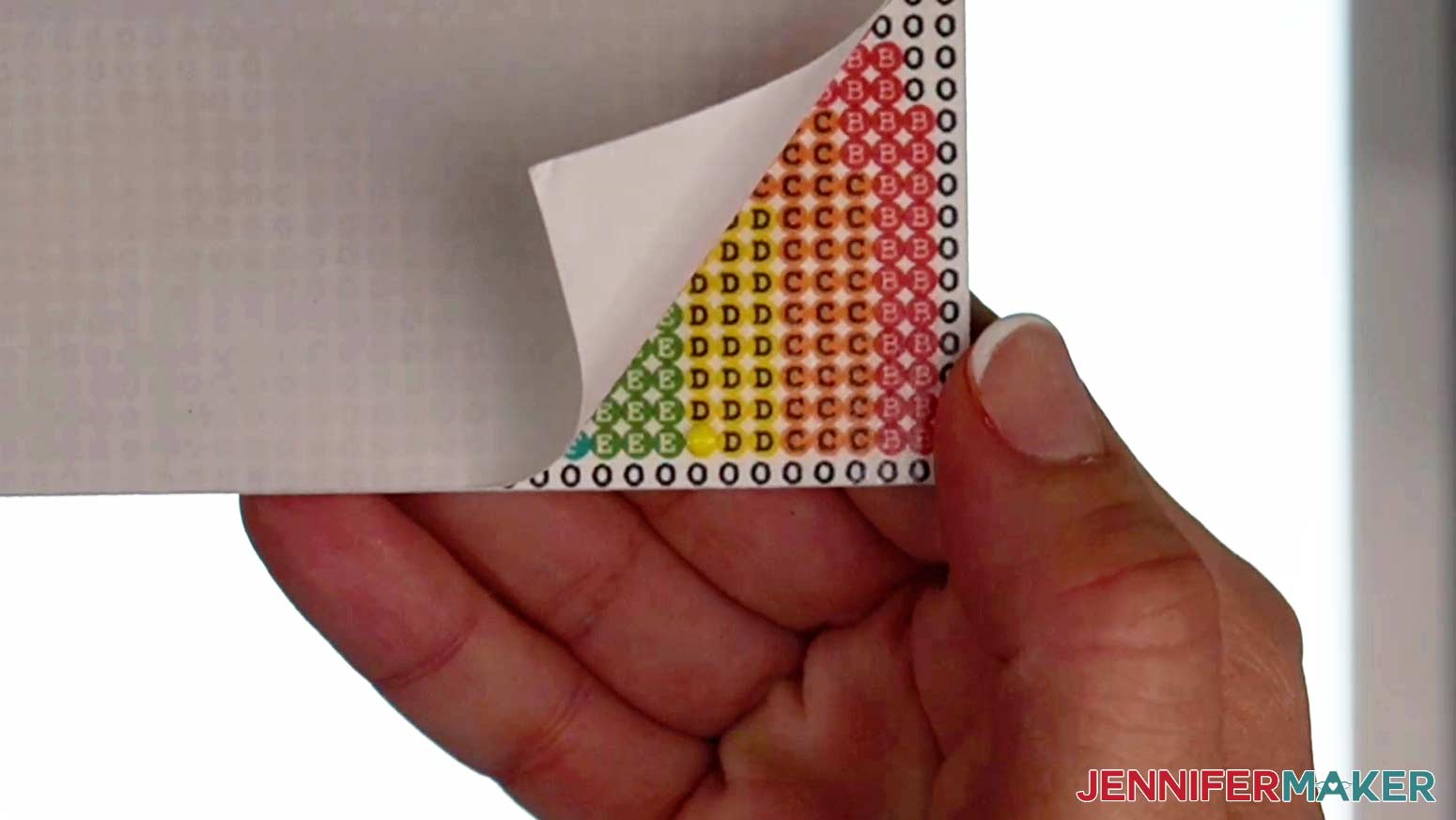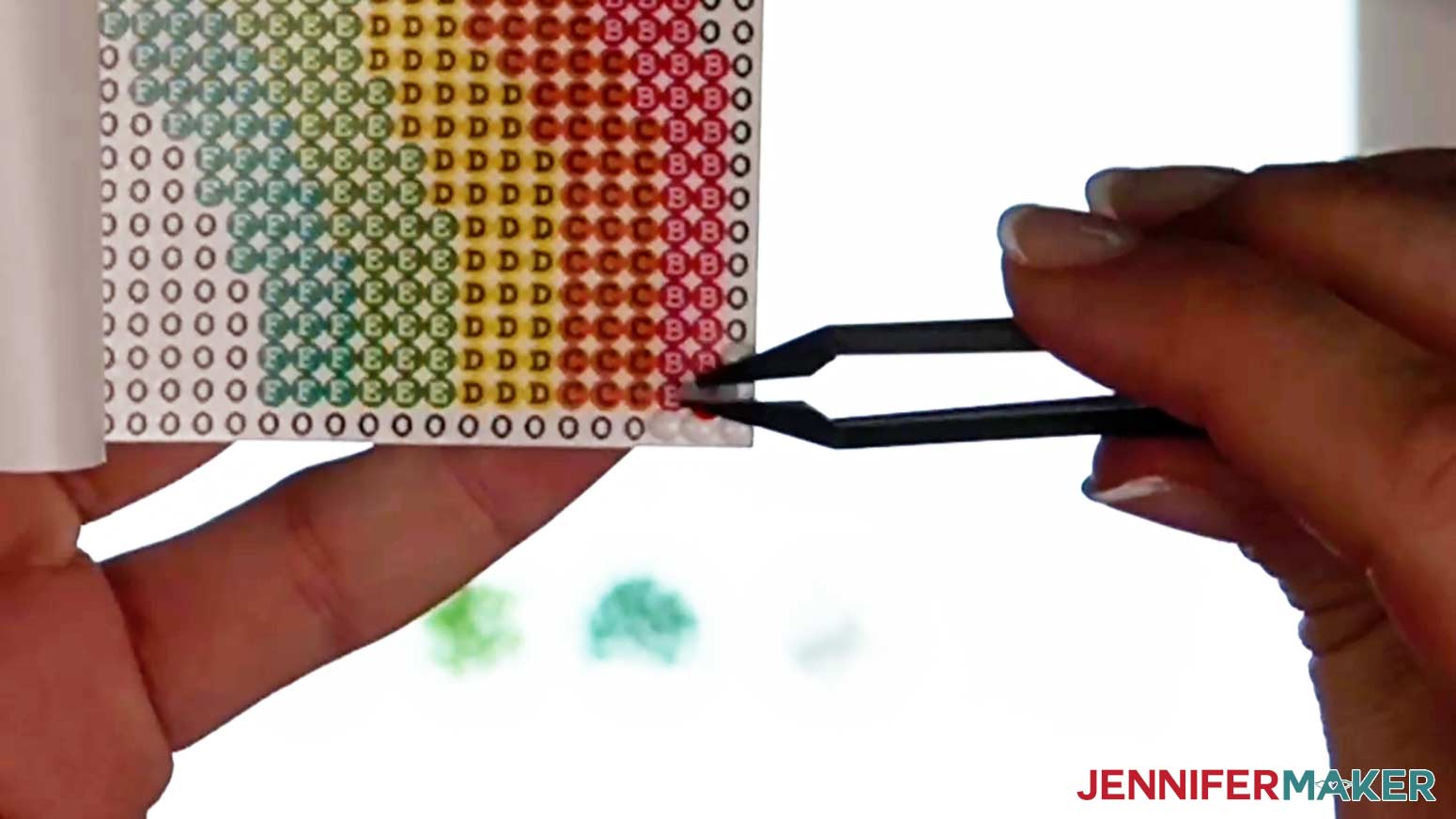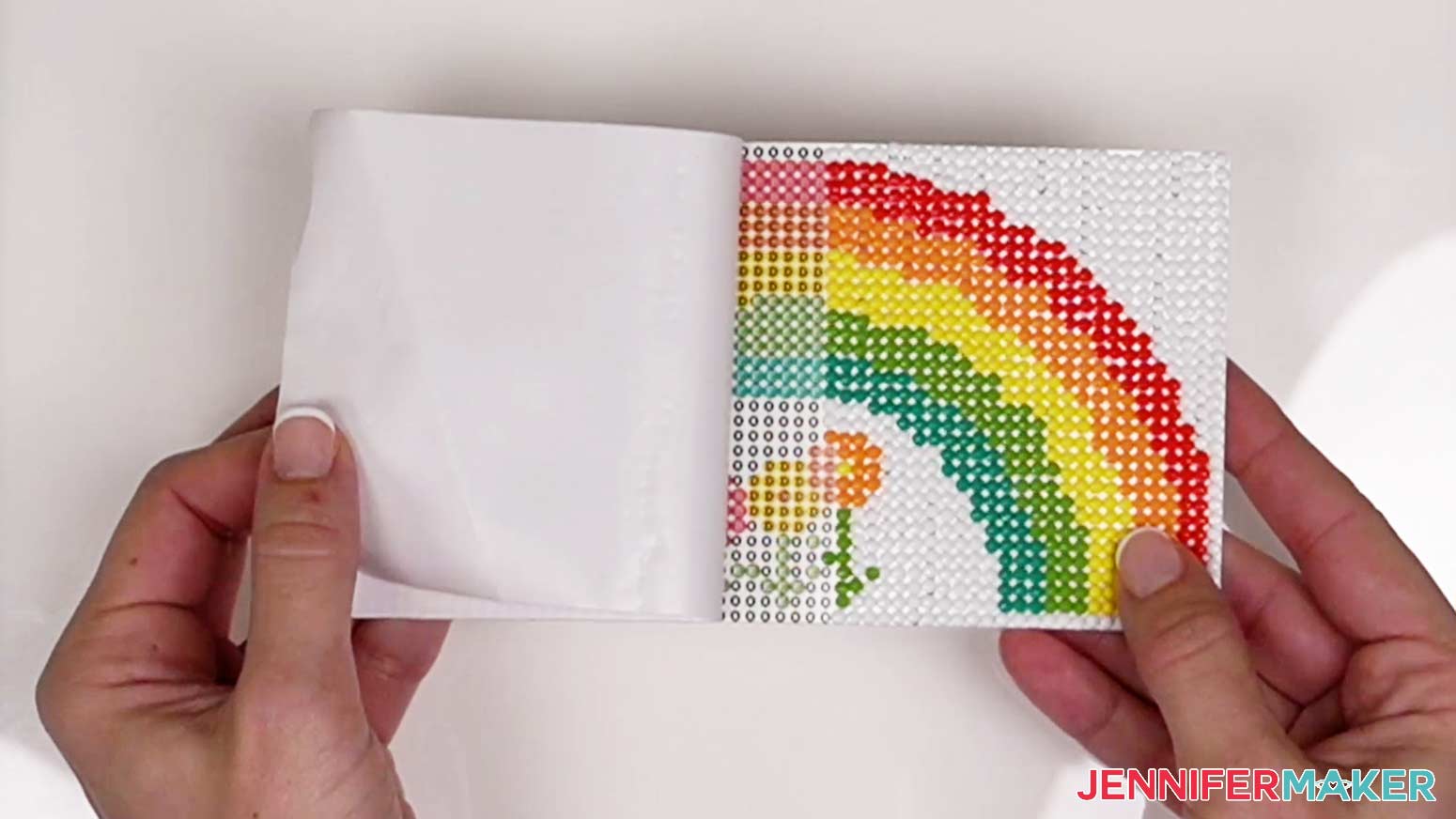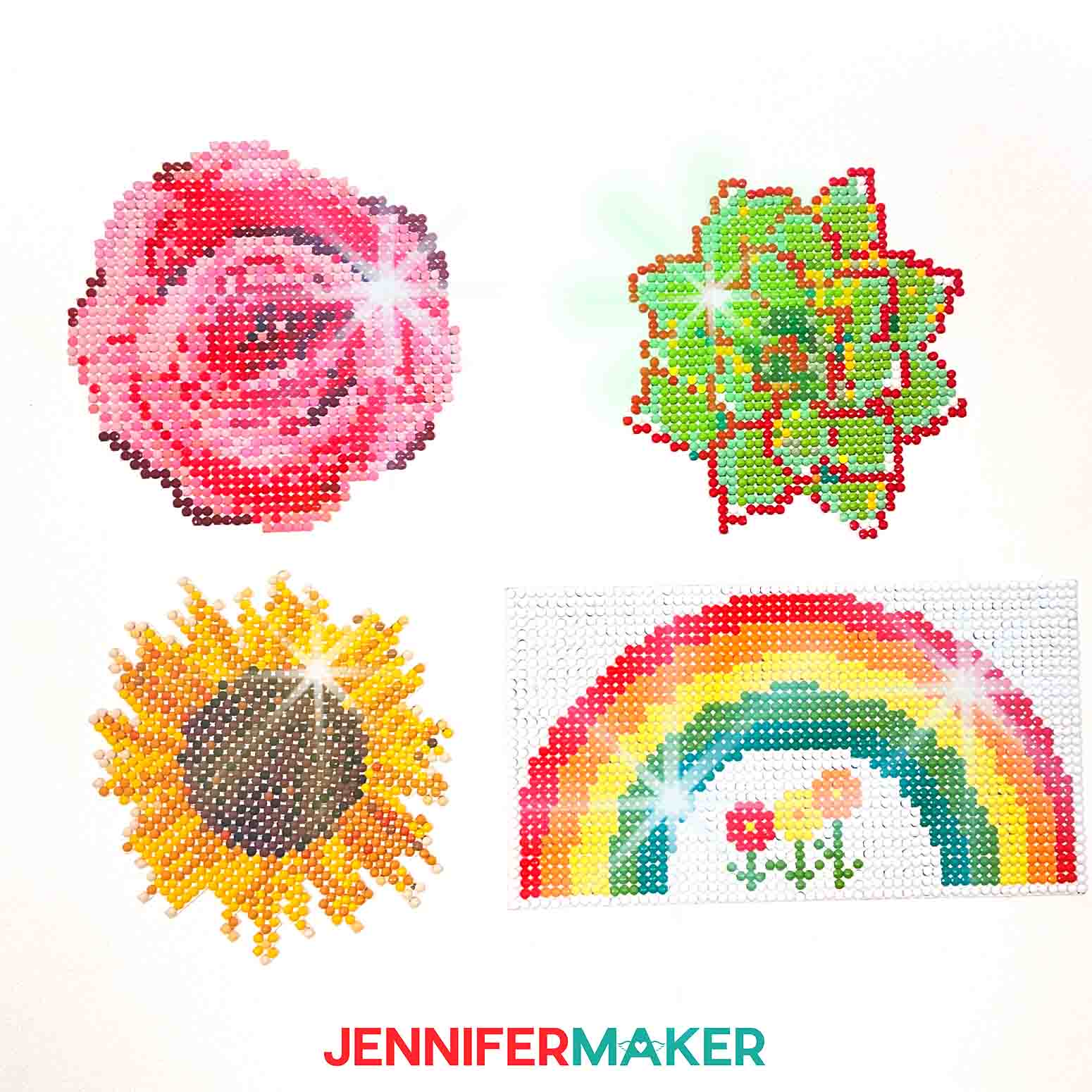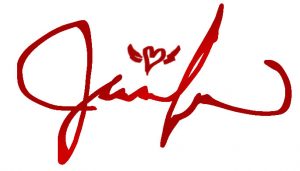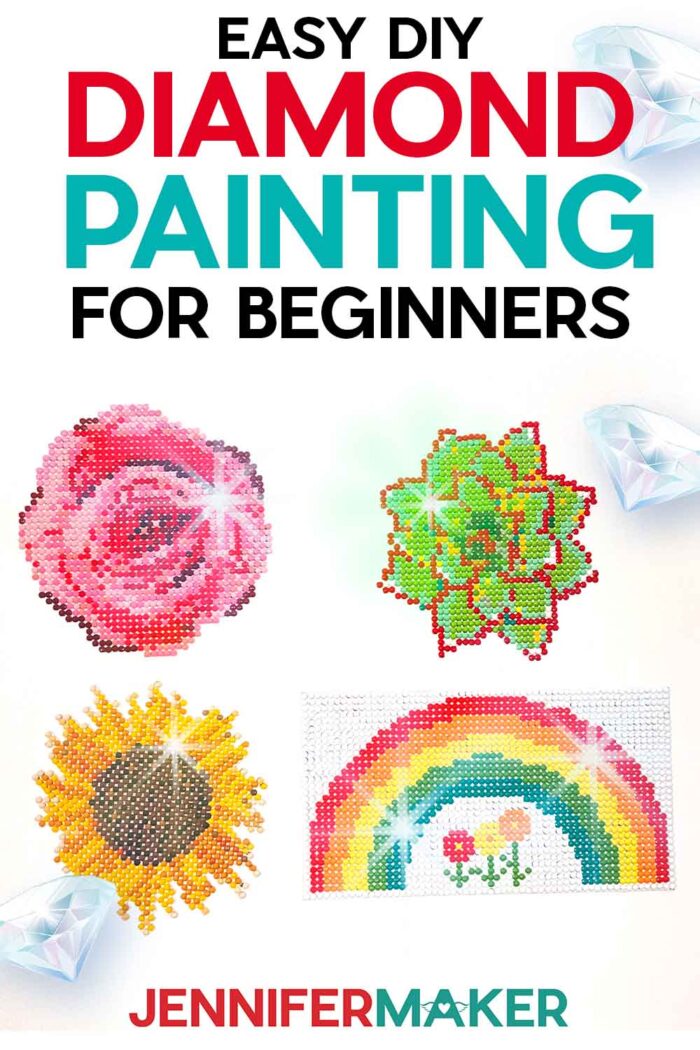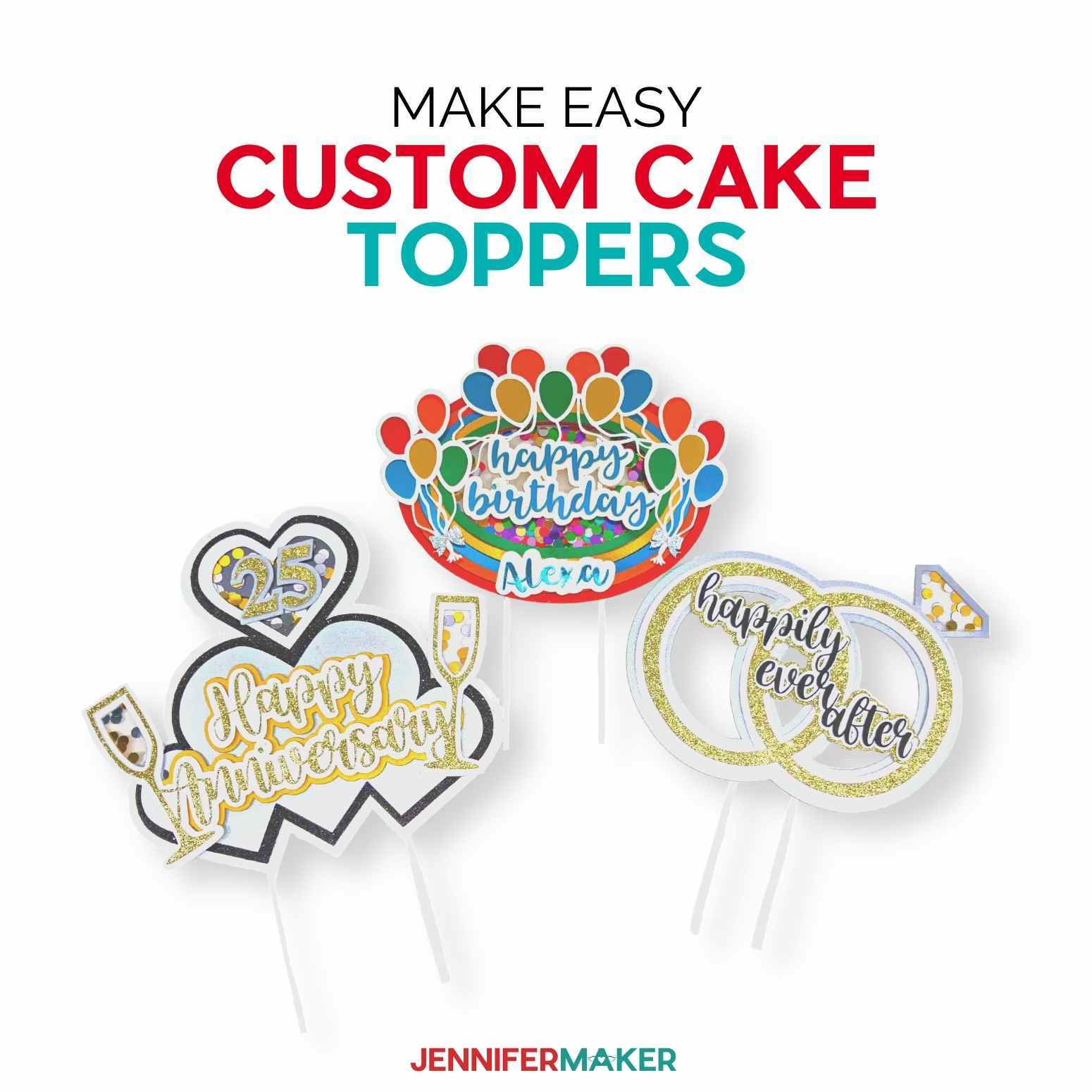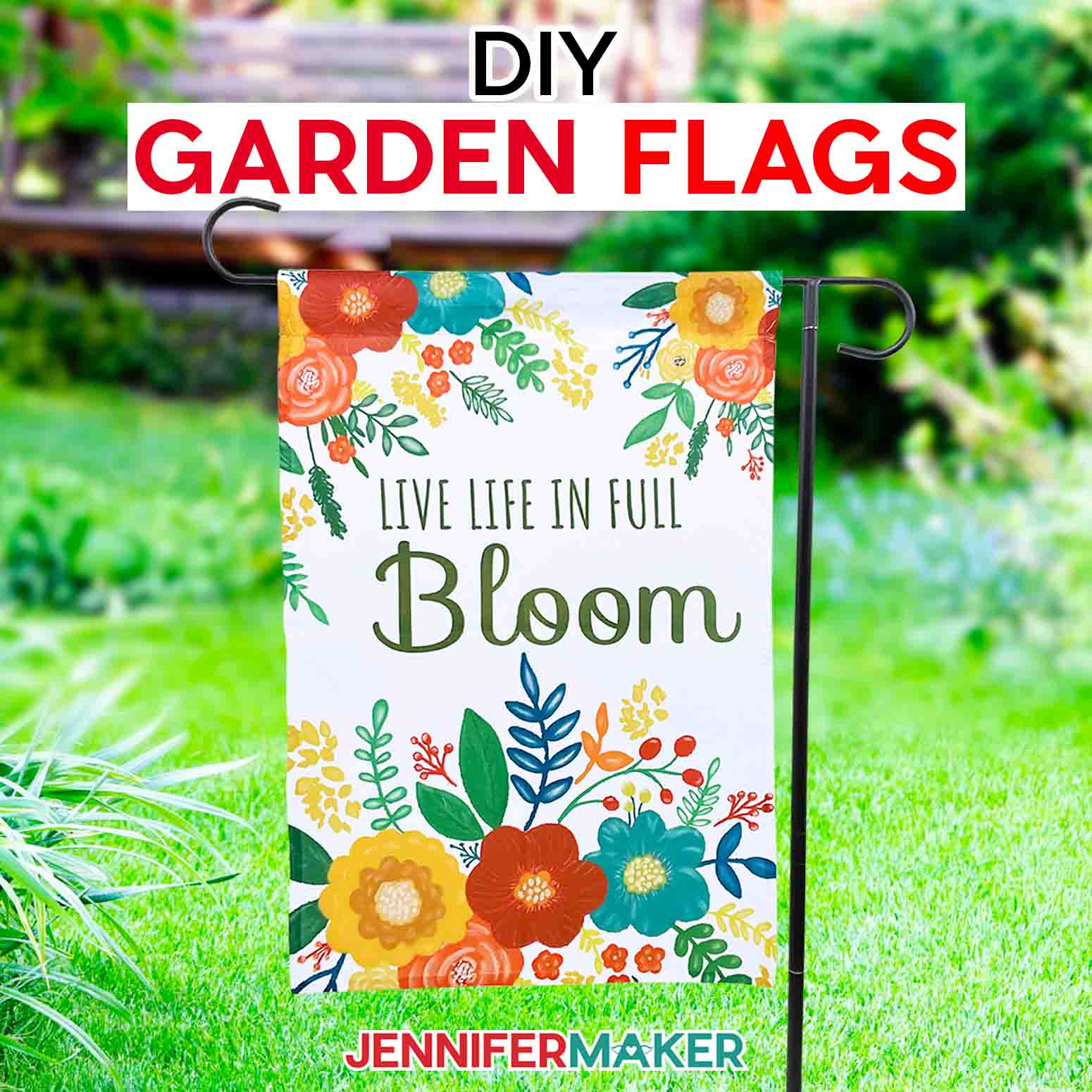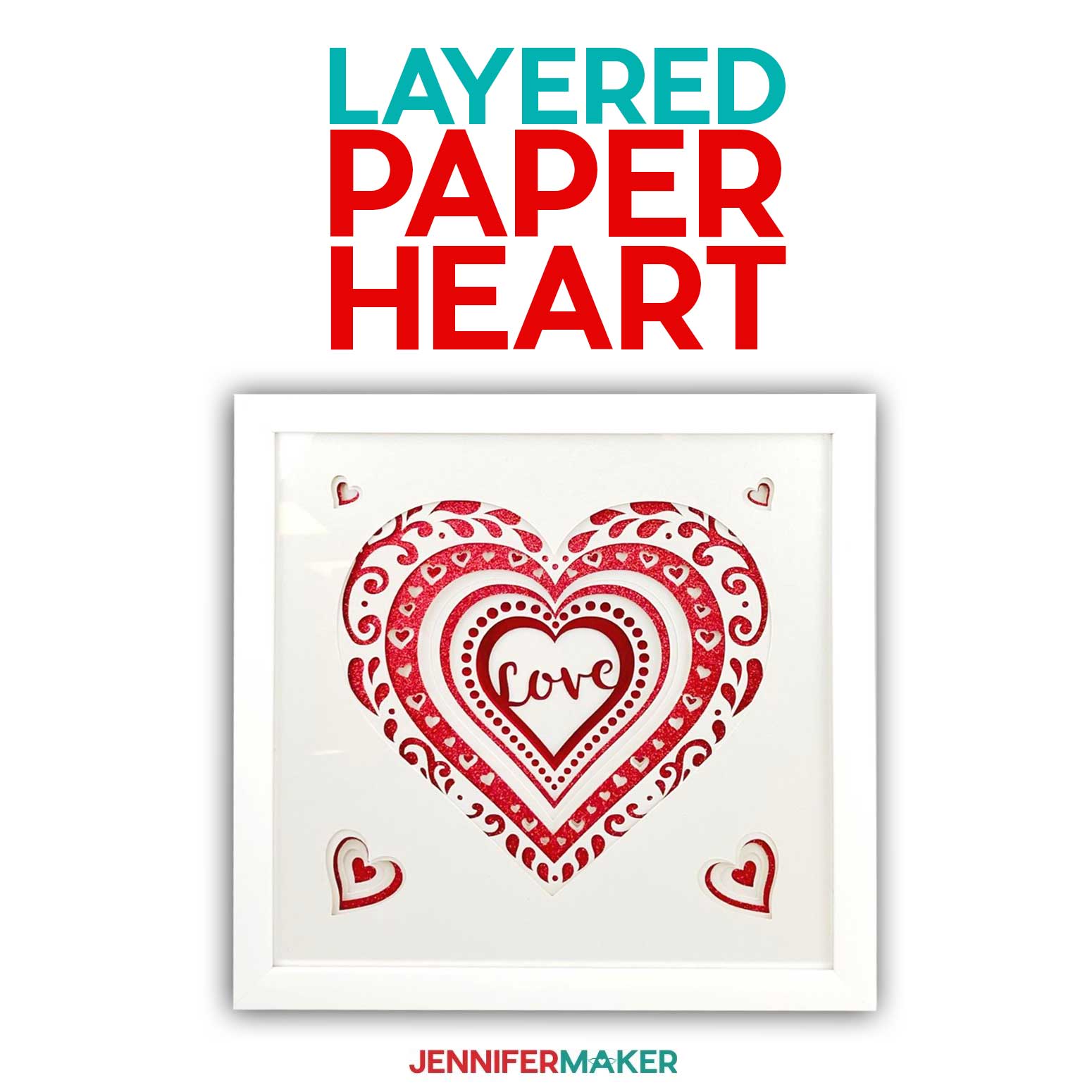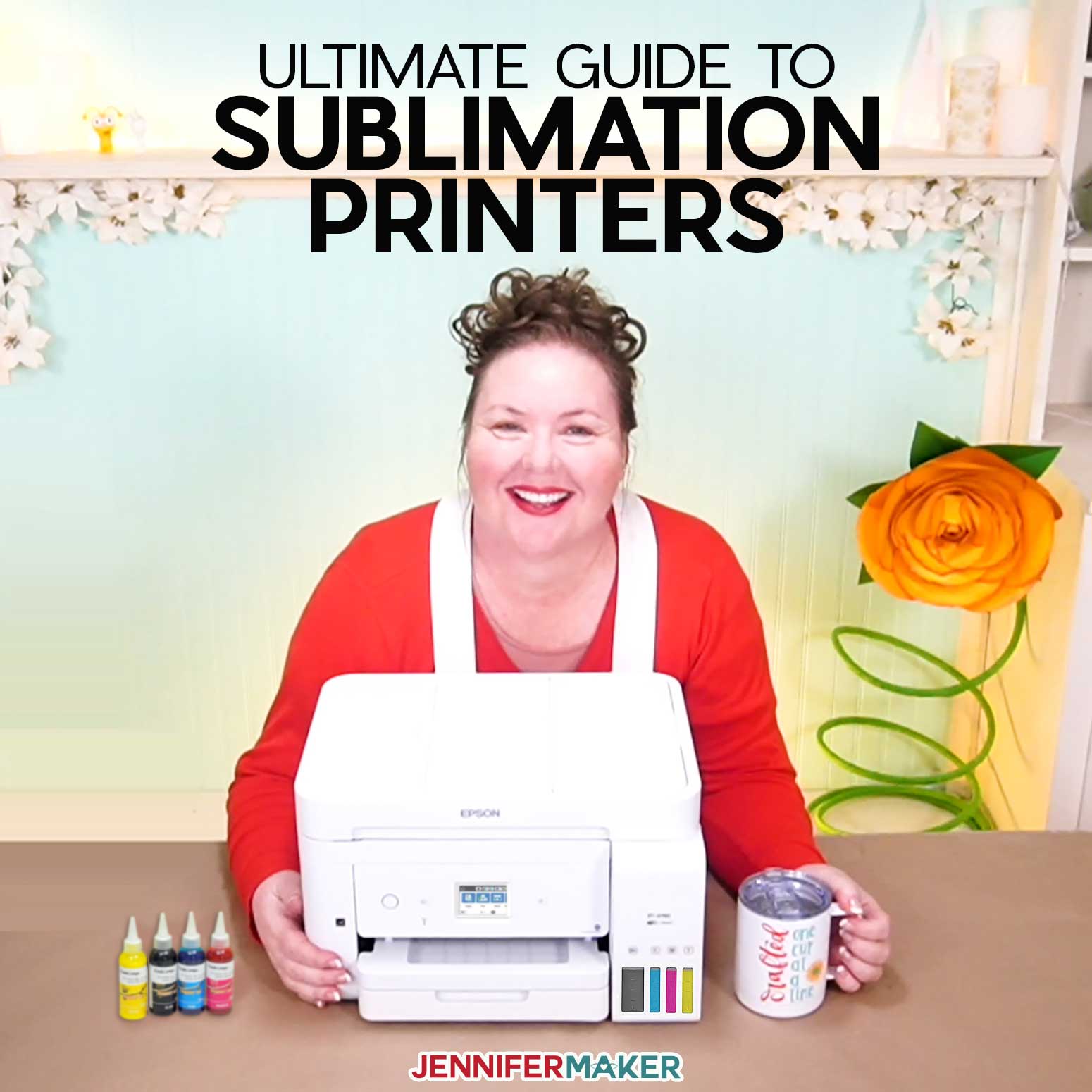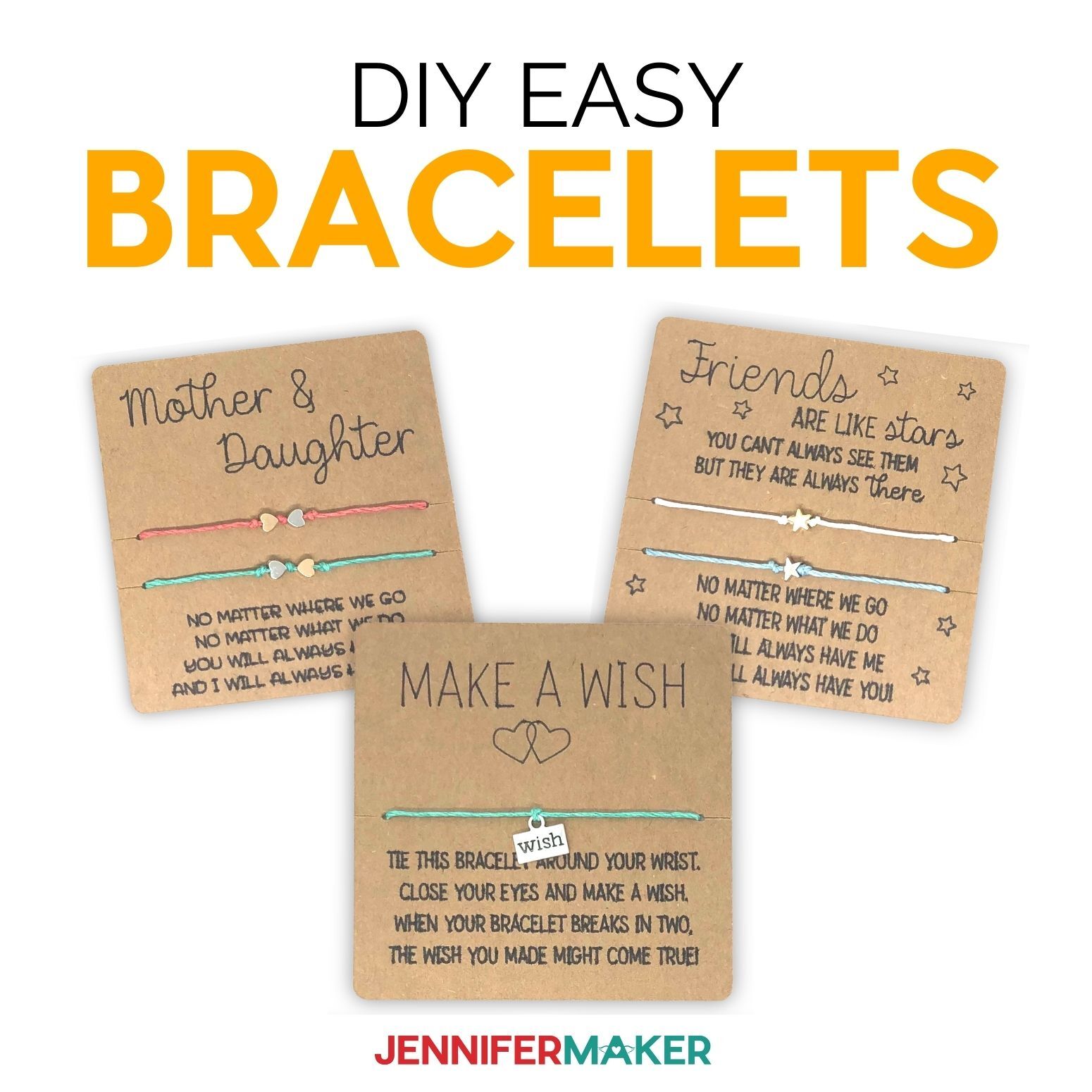Learn how to do diamond painting by hand or with a Cricut cutting machine!
Have you tried diamond painting yet? It’s like paint by numbers, but with diamonds! Ok, they’re not really diamonds, but the little plastic gems you stick to the pattern are nearly as sparkly, and a whole lot less expensive. Today, I have free designs for diamond painting for beginners and some ways your Cricut tools can make the hobby even more fun!
Watch the full step-by-step diamond painting for beginners tutorial!
 What is the Merry Maker Mingle? This is an annual tradition here at JenniferMaker! Every day for the first 25 days of December, we gift you with a brand new project, design, tutorial, and video for something YOU asked us to make. On top of that, we host a giveaway with 25 days of prizes. Some of the amazing prizes are Cricut cutting machines, sewing machines, gift cards, and beautiful print editions of our popular Cricut Coach Playbook. You can even earn bonus entries for sharing photos of the daily projects! Click here to learn more about the Merry Maker Mingle!
What is the Merry Maker Mingle? This is an annual tradition here at JenniferMaker! Every day for the first 25 days of December, we gift you with a brand new project, design, tutorial, and video for something YOU asked us to make. On top of that, we host a giveaway with 25 days of prizes. Some of the amazing prizes are Cricut cutting machines, sewing machines, gift cards, and beautiful print editions of our popular Cricut Coach Playbook. You can even earn bonus entries for sharing photos of the daily projects! Click here to learn more about the Merry Maker Mingle!When diamond painting projects started popping up in your requests for new projects, I knew we could use a Cricut to make the fun craft easier! And now we have, because I’ll show you how to make your own patterns with your cutting machine. You can use my free beginner-friendly designs to get started on a new craft hobby, and even design your own with the right software!
The patterns are similar to cross stitch designs, but you add epoxy gems (called diamond drills) to a sticky surface on top, instead of thread. Symbols tell you exactly which color to place in each spot, so it’s a great way to relax! I’ve even included color charts to help you keep track of (or even customize) your palette.
I’ll show you how to resize and prepare the rainbow design for use with Cricut Design Space and the Print then Cut feature on 8.5″ x 11″ white cardstock with a home color printer. But you can easily do it by hand, too, so I’ll show you both options! The same steps work for my other diamond painting for beginners designs, too.
I cut everything on my Cricut Maker 3, but you can use any Cricut machine to Print then Cut. If you want to use Print then Cut, you will need to use a Maker or Explore, since the Joy does not have that feature. You’ll need a Green StandardGrip Mat, brayer, and spatula, too.
Store-bought diamond art kits usually come with all the tools and materials needed to complete the design. But since we’re working with a custom diamond painting for beginners project, the tools and materials list has everything you need to get started.
The diamond painting kit I used comes with all the tools to complete a traditional project, like pens or diamond applicator tools, a small amount of wax, trays, and tweezers. It has pen tips that allow you to apply more than one diamond at a time, but I found the solo pen tip a little bit easier, especially for a new hobby. Sometimes, you want a craft to take a bit longer and it’s ok not to rush! The empty containers, labels, and funnels will help contain all the resin diamonds, too.
The bottom of a diamond drill is flat and the top dome is covered with cut facets to reflect light. That’s how they shine like real diamonds!
There are lots of drills on the market, but the main difference is the shape: round or square? Our designs work best with round drills, since they’re easier to line up than the square drill versions. Once you get the hang of the round diamonds, give the square diamonds a shot! There are different designs available for each shape
But the drills themselves aren’t sticky. Usually, the pattern is layered with a protected adhesive material you expose in small sections to press each diamond on to the corresponding symbol with the pen tool and wax pad, creating the image. It’s so fun to watch it appear!
For a design you print at home, there are two ways to secure your drills: sticky paper or glue. I chose nifty double-sided adhesive paper because it’s less messy and works with my Cricut, but I’ve also listed the glue kit below. Just follow the directions on the bottle and you’ll be all set! The gloves I have listed will keep your hands clean, too!
A craft knife and ruler will also be useful when we add the adhesive paper. And if you have a BrightPad, we found that one really helps while adding the diamonds, but it’s optional. Don’t forget scissors to open your bags of diamonds and painter’s tape to keep your projects in place!
Let me show you how fun it is to start diamond painting for beginners and how a Cricut can make it easier! This post contains some affiliate links for your convenience (which means if you make a purchase after clicking a link I will earn a small commission but it won’t cost you a penny more)! Read my full disclosure policy.
Materials for Diamond Painting for Beginners
View my Amazon shopping list with the exact items we used to make this project
- Round Diamond drills – I used this Variety Pack that comes with different colors in plastic bags
- Adhesive Paper – Two-sided, Clear Adhesive
- Diamond Art Painting Glue Kit – I prefer the adhesive sheets, but this is a good alternative.
- White 65lb cardstock 8.5×11
- Tool Kit for Diamond Painters
- Inkjet Printer
- A method to cut your templates: I used the amazing Cricut Maker 3, but you can also use the Cricut Maker, or Cricut Explore Series, or just a pair of scissors
- Green StandardGrip Mat (12″ x 12″
- Brayer Tool
- Scissors
- Cricut TrueControl Knife or a normal crafting knife
- Spatula
- Cricut BrightPad
- Nitrile Gloves – if you choose to use glue instead of adhesive sheets
- Design #462 (My free SVG/PDF/DXF design files available in my free resource library – get the password by filling out the form at the bottom of this page)
How to Start Diamond Painting for Beginners
Learn how to make your own diamond painting art pieces that can be displayed by themselves or used as embellishments on other crafting projects! Diamond painting is a fun easy craft that produces bright, colorful, and shiny images after all the “diamonds” have been added to the adhesive surface of the paper or canvas. You can make your own diamond paintings using a color printer, an adhesive sheet or glue, and your Cricut! First, download my Diamond Painting PNG/PDF files from my free resource library. It's Design #462. The PNG files include a Succulent, a Rose, a Sunflower, and a Rainbow. The Rainbow design is the best design to start with if you’ve never done diamond painting before, but all the designs can be done by beginners and are small enough to complete in a few hours each. Diamond painting designs are very similar to cross stitch designs in that the crafter follows a pattern to know what colors to apply to the design and where to apply them. The PNG files will print the pattern onto cardstock, but the PDF files will explain which colors are needed and where they go so be sure to download and print them at the same time as the PNG files. There are two versions of PDF files - one with grid lines and one without. Feel free to use either version as a color chart. The PNG files can also be printed and filled in without using Print Then Cut on a Cricut, but they do need to be printed at the right size I’ve listed below, and will need to be cut around by hand, if needed, for the final intended use. The PDF pages are also able to be printed and filled in without the use of a Cricut, but make sure to not allow the printer to "fit to size" or scale the pages in any way. The charts are already sized correctly on each page for this project. The PDF file without the grid lines is best to use as a base. The grid lines will show around the round drills. TIP: I created my diamond painting charts using cross-stitch design software. This tutorial does not explain design creation, but you can easily find software to allow you to do the same! I’ll show you how to prepare each of the images for Print Then Cut, and then show you how to fill in the designs with diamonds! First, upload the PNG of each design to Design Space. To do so, click “Upload” on the bottom left of the menu next to your canvas, then click “Upload Image.” Next click “Browse” and select the Rainbow PNG file. A Select Image Type menu will appear along with a preview of the image on the left side of the screen. You'll see the design, but also the letters and numbers we'll use to tell which color "diamond drills" (the colorful dots or squares) go where to create the image. Select the “Complex” option to make sure to preserve the colors and details. Choosing the “Simple” option can sometimes result in color changes you aren’t expecting when you want to keep all the colors that are already in the image. Click “Continue.” My files do not need any backgrounds removed, so Click “Apply & Continue” on the next screen. Design Space will now show you two images: the one on the left is the outline of the image, and the one on the right is the Print Then Cut image we need to use. Select the Print Then Cut version, and click “Upload.” Select the image in the preview area, then click "Add to Canvas." If you're making the others, follow these steps to add each of the other three designs to the Canvas. The designs will appear on the canvas at a larger size than necessary because PNG files are saved with a lot of detail and that usually translates into larger size images to hold all the information. We’ll need to make each image the correct size before proceeding. The following steps can be applied to any diamond painting design that is uploaded to the Design Space canvas to ensure sure they are sized correctly. Approximately 9 to 9.5 drills fit in an inch wide for most designs. It’s not an exact number because of slight variations in manufacturing, but we can use this average size to make a guideline to resize the PNG design. To make a guideline, first add a square shape to the canvas by clicking the “Square” in the “Shapes” menu on the left-hand side of the canvas. Now, with the square selected on the canvas, make sure the lock is open above the size menu then change the size of the square to 1” x .125”. Change the square to a guideline by clicking “Guide” under the Operation menu. Move the guideline over a spot with circles and zoom in so you can see how many of the symbols fit within the guide rectangle. Select the image and click and drag in from a corner to reduce its size until approximately 9 to 9.5 symbols fit inside the guideline. Reducing each of the images to fit the right number of circles in the guideline will make them close to the following sizes: Rainbow – 6.5” wide Sunflower – 4.5” wide Succulent – 4.25” wide Rose – 4.25” wide. Once all the images have been reduced to the proper size, they are all ready to print! Check that the right machine is listed in the top corner, then click "Make It!" Your designs will appear on mats with extra border markers around them. The Cricut will use the border markers to know where to cut when the images are loaded. All four images can print and cut onto two mats. Make sure the correct Material Size is selected for each mat. I found 8.5” x 11” 65lb cardstock works perfectly to print to and to hold the diamond drills on these small designs. Leave “Mirror” turned off and click “Continue” Click “Send to Printer”. A Print Setup box will open to allow you to make some choices about how to print your mats. Make sure the correct printer is selected, the correct number of copies you wish to print are entered, and the “Add Bleed” setting is turned off. Unless you want to make changes to the way a page prints in your printer’s own print menu, also leave “Use System Dialog” turned off. TIP: If you experience print quality issues, you may need to turn on “Use System Dialog” to edit the quality settings to a higher quality for your printer. Before clicking “Print”, make sure the cardstock is loaded in your printer. If you experience difficulties with printing on the 65 lb cardstock, and your printer has a load slot for thicker materials, use the special load area for thicker materials. Click “Print” Your mat will print to your printer. Once the print is complete, place the first piece of cardstock on your green StandardGrip mat and make sure it has adhered well by pressing it with your brayer. Before cutting the images, choose adhesive sheets or glue as the way to adhere the diamond drills to the cardstock. I prefer the adhesive sheets because there is no glue mess or waiting for glue to dry, but diamond glue kits are available that are specially formulated for ease of use with diamond painting crafts. (If you choose to use diamond glue, skip the following adhesive sheet application directions, and begin cutting your images.) The adhesive paper needs to be added to the cardstock before cutting so it will cut into the same shape as the image. This can be done in two different ways. Then, remove the backer from one side to expose the adhesive. Apply the exposed adhesive side to the image on the cardstock using the same method as applying transfer tape to vinyl. Shape the cut piece of adhesive paper into a “taco” and center it over the images. Lay down the center first and press out from the middle to each side. Use a brayer to make sure there are no bubbles in the adhesive layer, and that it has well adhered to the cardstock. OR 2. Cut a piece of adhesive paper that is slightly larger than the registration marks and adhere it to the cardstock in the same method as above. Once applied, the adhesive sheet is thin enough to allow the colors of the bounding box and the images to be seen under the adhesive paper, but because the Cricut needs to more clearly see the marks, part of the cover of the adhesive must be removed. To do so, use a craft knife to cut around the inside of the bounding box taking care not to cut over the images. Peel away the extra part of the cover to expose the adhesive that is over the bounding box, leaving the images protected with the remaining piece of the cover. The adhesive over the bounding box will be exposed, but it will not interfere with the Cricut cutting process. Whichever approach you picked, your mat is ready to cut. The Cricut must cut through both the adhesive and cardstock layers, so I used “Heavy Cardstock – 100 lb.” as the “Material” setting with “More Pressure”. I did test “Medium Cardstock – 80 lb.” but the cuts were inconsistent for me. Every machine is different, so you may need to test settings before finding one that works correctly. Load the mat into your Cricut and press the flashing button to begin. TIP: If you run into any issues cutting your materials, check out my Cricut Tips & Tricks for Cleaner Cuts. Once the cutting is complete, and before unloading your mat, check to see if the cut went all the way through. If not, press Start for another pass. When the cut is all the way through, use a pencil or pen to make a small “T” shape mark at the top of each image design on the backer. This mark will allow you to easily tell which side of the piece is the backer that needs to be removed to expose the adhesive later. Remove the cut pieces from the mat by turning the mat over and rolling it away from the cardstock. Continue to print, load, cut, and remove mats until all the pieces are cut. Always be sure you load the correct printed sheet to match the mat on the screen before pressing the arrow button! The “diamond” bits are called drills. There are different types available that can give your finished project different looks. For this project, we are using round drills, but square drills are also available. Round drills are generally easier to pick up and place and reflect light a little better than square drills, so they appear shinier. The drawback to round drills is that you will see a little of the cardstock behind the image as the round drills don’t fit perfectly together as square drills do. The following instructions are for filling in a design while using the adhesive sheets. If you decide to use glue instead, follow the instructions that came with your glue kit for applying the glue to the cardstock. I’ll use the Rainbow and Flowers design to demonstrate. Grab the pattern's color chart to see how many of each color drills you'll need. The chart will show a letter or symbol that represents the color on the chart, a number for the color instead of a color name, and a quantity that shows how many drills are needed for that specific color. TIP: Most drills on the market match their color numbers to the numbers given to colors of DMC Embroidery thread. It is possible to use an embroidery chart to make a diamond painting if it is printed at the right size! Gather all the colors you will need for the design. They are usually supplied in bags or small containers with color numbers printed on the outside. If the bags are in manufacturer bags that need to be cut open (like the drill kit I recommend) make sure to have resealable containers handy to label and store unused drills. Pour a small handful of each drill color into flat containers that allow the drills to spread out. The trays that come with most tool kits are specially made to allow the drills to lay flat into rows, so they are ready to be picked up. Many colors are very similar to each other so leave a label or the closed container next to each tray to identify the color. Now it’s time to load some wax into the end of a diamond pen tool. This is a long thin tube that has a hollow tip. If you are using the wax for the first time, there is a plastic protective film on top that needs to be removed. Press the metal tip to into the wax and when you lift it there will be sticky wax in the tube. That helps pick up the drills. Carefully peel back part of the cover on the adhesive to expose the sticky area and design. It’s best to only uncover a few lines at a time so the adhesive stays clean on the other parts of the image. Now, look at the letters or symbols printed on the exposed area and find the drills you'll need. If you have trouble seeing the letters or symbols (because they are small!) place the design on a Cricut BrightPad. The light shines through the cardstock to make the printed parts show more clearly. Decide if you want to fill in all drills of the same color in a specific area, or fill in the line from left to right regardless of the colors used. I find it easier to move from left to right over the design picking up each color that is needed as I go, rather than leave holes in the design to be filled in by other colors, but it is entirely your choice. Choose a color and pick up a corresponding drill using the wax end of the pen. The round drills fit right into the opening. Carefully press the drill into the spot on the design that matches its color and location. When the pen tool is pulled away, the drill is left behind and stuck to the adhesive on top of the cardstock! Sometimes, the pen tool may be overfilled with wax and will leave a bit behind with the drill. Make sure to wipe the wax away from the adhesive or the next drill will not want to stick. Continue filling in all the letters or symbols with the correct color drills in one area before exposing the adhesive on the next few lines. Special pen tips allow you to pick up more than one drill of the same color at a time for faster filling, but I found I prefer to use the single drill tip for more precise alignments. You can experiment to see what you prefer! Slowly work your way through the whole design. It can take hours to fill in each design so be patient and place each drill as precisely as possible. These designs are small to allow for Print Then Cut, so it may be difficult to hold the cardstock in place with one hand while placing the drills with the other. Sitting the cut cardstock shapes back down on to a cutting mat may help hold things in place. (The only drawback is that you will not be able to use the BrightPad and will have to light the design in more direct ways, if necessary.) Alternatively, you can use painter's tape to adhere the image to the BrightPad. If you happen to place the wrong color into a spot, you can remove it with the edge of a fingernail or tweezers if you are careful to not scrape away the adhesive underneath! After all the drills have been filled in, the piece is ready to mount to your project, or give as a gift! These designs are the perfect size to use as applique pieces on cards, as elements in shadow boxes, and as gifts! Final Size: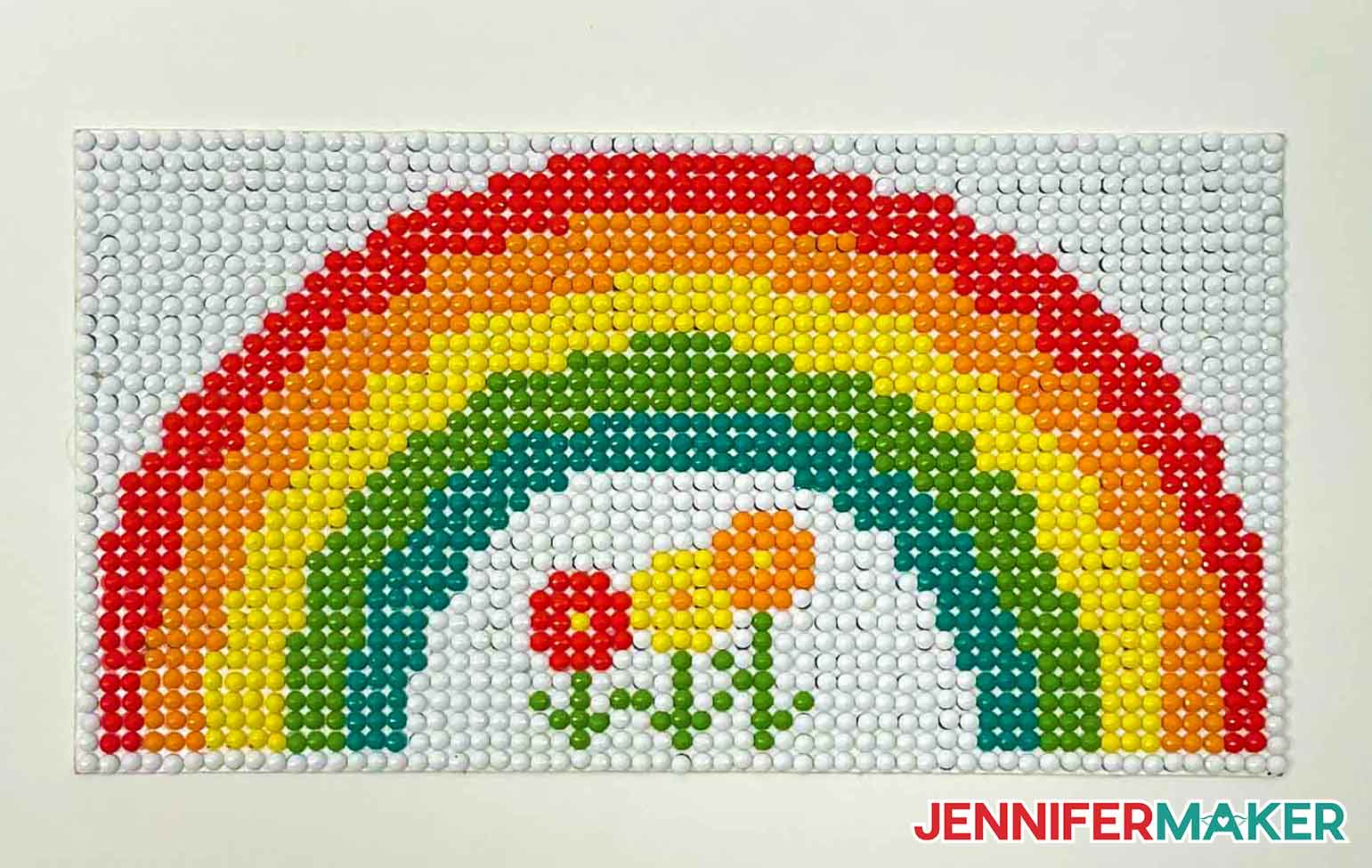
Diamond Painting for Beginners
Materials
Tools
Instructions
STEP 1: GET MY FREE DIAMOND PAINTING DESIGN FILES
STEP 2: PREPARE THE DESIGN FILES
STEP 3: PRINT THEN CUT THE DIAMOND PAINTING DESIGNS
1. Measure the design to find the dimensions that are larger than the printed image, but smaller than the registration marks. Cut the adhesive paper to match.STEP 4: FILL IN YOUR DESIGN
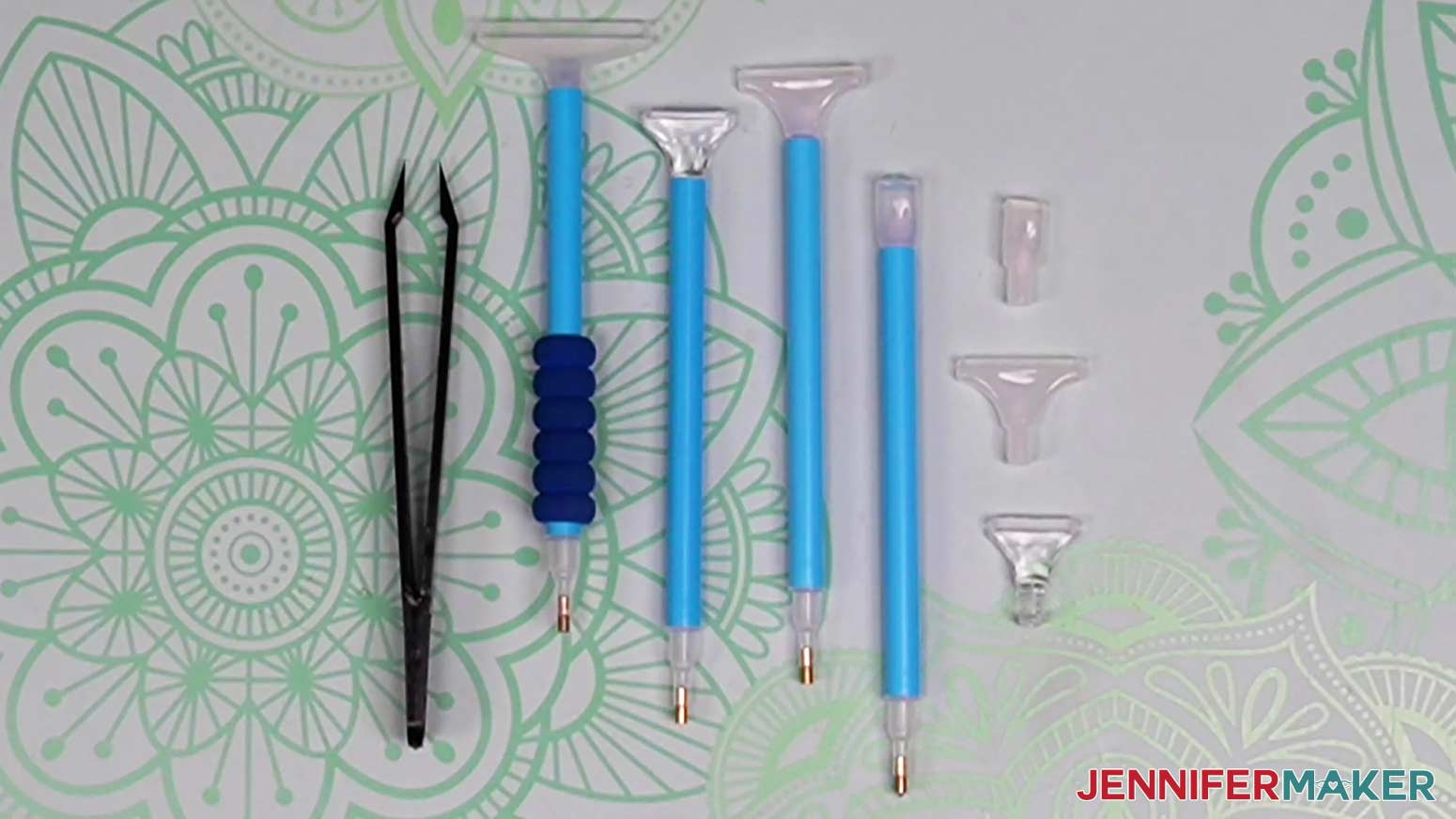
STEP 5: SHOW IT OFF!
Notes
Rainbow – 6.5” x 3.53”
Sunflower – 4.5” x 4.18”
Succulent – 4.25” x 3.93”
Rose – 4.25” x 4.36”
Answers to Your Questions About Diamond Painting for Beginners
Q: How do I get started with diamond painting?
The first thing is to pick a design! A simple project like one from my free collection is a good way to start because they only take a few colors and only take a few hours to complete.
Q: Are diamond paintings easy?
There wouldn’t be so many happy diamond painters if the hobby was too hard to enjoy! The first time you try might take some time to get the application smooth, but then you’ll have a great time!
Q: What are must haves for diamond painting?
Most kits at craft stores come with the necessary diamond painting tools: a pen applicator, pink wax, and drill trays. Washi tape is also helpful to hold the plastic film out of the way.
Q: How can I make a custom diamond painting design?
I used the paid version of cross stitch designing software to make my own photo into a design. The software is available for Apple computers (MacStitch) or Windows computers (WinStitch).
Q: Where is the best place to start on a diamond painting?
The best way to start depends on your dominant hand. It’s best to avoid touching the exposed areas of the sticky canvas, so pick a corner and lift some of the protective film, but leave it in place where your hand will touch.
Q: What do you do with leftover diamonds from diamond painting?
If you have large amounts of drills left over, you can label them in case you need them for a future project. If you have more than you’ll need, you can cover other items like coasters with the adhesive film and add them as a freestyle design!
Q: How many hours does it take to do a diamond painting?
The time to complete a design varies, but if it’s a small printed canvas or there are large blocks of one color, it will go faster!
Q: Should I seal my diamond painting?
You can seal the project as a final step, but it might make the diamonds less shiny.
Q: How do you keep diamonds from falling off diamond paintings?
Do your best to protect the sticky areas right up until you press the diamonds into place. Resist the urge to peel the clear plastic film off of the entire canvas! And once the project is done, you can run a brayer over the surface as a final step to really press the drills into place.
Q: Can I cut this project on a Cricut Joy?
A: No, Cricut Joy cannot do Print then Cut.
Q: What is Merry Maker Mingle?
A: Each day in December leading to Christmas, I present you with a brand new “gift” — a project to craft, make, or do. You can make these projects on a Cricut cutting machine or by hand if you don’t have one. Most of our Merry Maker Mingle projects will come with a fun video with yours truly, a step-by-step printable photo tutorial, and a free pattern/SVG cut file. Sign up to get daily updates and prizes!
Get my free SVG files to start diamond painting for beginners!
I love seeing what you make with my designs and how you use them! Please share a photo of your easy diamond painting in our Facebook group or tag me on social media with #jennifermaker.
Love,

